A Decade of Modern Bridge Monitoring Using Terrestrial Laser Scanning: Review and Future Directions
Abstract
1. Introduction
2. Scientometric Review
2.1. Literature Search Methodology
2.2. Co-Occurrence of Keywords Analysis
2.3. Co-Authorship Analysis
2.4. Network of Countries/Regions and Institutions
3. State-of-the-Art Review
3.1. Generation of 3D Geometric Model
3.1.1. Data Acquisition
3.1.2. Three-Dimensional Model Generation
3.2. Quality Inspection
3.2.1. Crack Detection
3.2.2. Mass Loss, Scaling and Spalling
3.2.3. Corrosion, Water Bleeding, and Efflorescence
3.3. Structural Assessment
3.3.1. Geometric Modelling
3.3.2. Deformation Measurement
3.3.3. Inverse Engineering and Model Updating
3.4. Bridge Information Modeling (BrIM)
3.4.1. Progress Tracking
3.4.2. Quality Control, Management and Operation
4. Discussion and Future Directions
4.1. Overview of the Scientometric Review
4.2. Future Directions
5. Conclusions
Author Contributions
Funding
Conflicts of Interest
References
- Riveiro, B.; Lindenbergh, R. Laser Scanning: An Emerging Technology in Structural Engineering; CRC Press: Boca Raton, FL, USA, 2019; p. 270. [Google Scholar]
- American Society of Civil Engineering (ASCE). Infrastructure Report Card; ASCE: Reston, VA, USA, 2017.
- Iles, D.C. Design Guide for Steel Railway Bridges; Steel Construction Institute: Ascot, UK, 2004. [Google Scholar]
- Rashidi, M.; Gibson, P. A methodology for bridge condition evaluation. J. Civ. Eng. Arch. 2012, 6, 1149–1157. [Google Scholar]
- Rashidi, M.; Samali, B.; Sharafi, P. A new model for bridge management: Part a: Condition assessment and priority ranking of bridges. Aust. J. Civ. Eng. 2016, 14, 35–45. [Google Scholar] [CrossRef]
- Žnidarič, A.; Pakrashi, V.; O’Brien, E.; O’Connor, A. A review of road structure data in six european countries. Proc. Inst. Civ. Eng. Urban Des. Plan. 2011, 164, 225–232. [Google Scholar] [CrossRef]
- Fujino, Y.; Siringoringo, D.M. Structural health monitoring of bridges in japan: An overview of the current trend. In Proceedings of the Fourth International Conference on FRP Composites in Civil Engineering, CICE, Zurich, Switzerland, 20–25 July 2008. [Google Scholar]
- Rashidi, M.; Hoshyar, A.N.; Smith, L.; Bijan, S.; Siddique, R. A comprehensive taxonomy for structure and material deficiencies, preventions and remedies of timber bridges. J. Build. Eng. 2020, 101624. [Google Scholar] [CrossRef]
- Transport for NSW Office. Roads and Maritime Services’ Annual Report; TfNSW: Sydney, NSW, Australia, 2019.
- Son, H.; Bosché, F.; Kim, C. As-built data acquisition and its use in production monitoring and automated layout of civil infrastructure: A survey. Adv. Eng. Inf. 2015, 29, 172–183. [Google Scholar] [CrossRef]
- Pătrăucean, V.; Armeni, I.; Nahangi, M.; Yeung, J.; Brilakis, I.; Haas, C. State of research in automatic as-built modelling. Adv. Eng. Inf. 2015, 29, 162–171. [Google Scholar] [CrossRef]
- Lu, Q.; Lee, S. Image-based technologies for constructing as-is building information models for existing buildings. J. Comput. Civ. Eng. 2017, 31, 04017005. [Google Scholar] [CrossRef]
- Wang, Q.; Kim, M.K. Applications of 3d point cloud data in the construction industry: A fifteen-year review from 2004 to 2018. Adv. Eng. Inf. 2019, 39, 306–319. [Google Scholar] [CrossRef]
- Kim, M.K.; Wang, Q.; Li, H. Non-contact sensing based geometric quality assessment of buildings and civil structures: A review. Autom. Constr. 2019, 100, 163–179. [Google Scholar] [CrossRef]
- Spencer, B.F.; Hoskere, V.; Narazaki, Y. Advances in computer vision-based civil infrastructure inspection and monitoring. Engineering 2019, 5, 199–222. [Google Scholar] [CrossRef]
- Czerniawski, T.; Leite, F. Automated digital modeling of existing buildings: A review of visual object recognition methods. Autom. Constr. 2020, 113, 103131. [Google Scholar] [CrossRef]
- Pollack, J.; Adler, D. Emergent trends and passing fads in project management research: A scientometric analysis of changes in the field. Int. J. Proj. Manag. 2015, 33, 236–248. [Google Scholar] [CrossRef]
- Chen, C. Citespace ii: Detecting and visualizing emerging trends and transient patterns in scientific literature. J. Am. Soc. Inf. Sci. Technol. 2006, 57, 359–377. [Google Scholar] [CrossRef]
- Su, H.-N.; Lee, P.-C. Mapping knowledge structure by keyword co-occurrence: A first look at journal papers in technology foresight. Scientometrics 2010, 85, 65–79. [Google Scholar] [CrossRef]
- Song, J.; Zhang, H.; Dong, W. A review of emerging trends in global ppp research: Analysis and visualization. Scientometrics 2016, 107, 1111–1147. [Google Scholar] [CrossRef]
- Cobo, M.J.; López-Herrera, A.G.; Herrera-Viedma, E.; Herrera, F. Science mapping software tools: Review, analysis, and cooperative study among tools. J. Am. Soc. Inf. Sci. Technol. 2011, 62, 1382–1402. [Google Scholar] [CrossRef]
- Chen, C.; Ibekwe-SanJuan, F.; Hou, J. The structure and dynamics of cocitation clusters: A multiple-perspective cocitation analysis. J. Am. Soc. Inf. Sci. Technol. 2010, 61, 1386–1409. [Google Scholar] [CrossRef]
- Elsevier. Scopus Global Research Factsheet. Available online: https://www.elsevier.com/solutions/scopus (accessed on 18 November 2020).
- Van Eck, N.J.; Waltman, L. Software survey: Vosviewer, a computer program for bibliometric mapping. Scientometrics 2010, 84, 523–538. [Google Scholar] [CrossRef]
- Perianes-Rodriguez, A.; Waltman, L.; van Eck, N.J. Constructing bibliometric networks: A comparison between full and fractional counting. J. Informetr. 2016, 10, 1178–1195. [Google Scholar] [CrossRef]
- Oraee, M.; Hosseini, M.R.; Papadonikolaki, E.; Palliyaguru, R.; Arashpour, M. Collaboration in bim-based construction networks: A bibliometric-qualitative literature review. Int. J. Proj. Manag. 2017, 35, 1288–1301. [Google Scholar] [CrossRef]
- León-Robles, C.A.; Reinoso-Gordo, J.F.; González-Quiñones, J.J. Heritage building information modeling (h-bim) applied to a stone bridge. ISPRS Int. J. Geo-Inf. 2019, 8, 121. [Google Scholar] [CrossRef]
- Cabo, C.; Ordóñez, C.; Argüelles-Fraga, R. An algorithm for optimizing terrestrial laser scanning in tunnels. Autom. Constr. 2017, 83, 163–168. [Google Scholar] [CrossRef]
- Argüelles-Fraga, R.; Ordóñez, C.; García-Cortés, S.; Roca-Pardiñas, J. Measurement planning for circular cross-section tunnels using terrestrial laser scanning. Autom. Constr. 2013, 31, 1–9. [Google Scholar] [CrossRef]
- Popescu, C.; Täljsten, B.; Blanksvärd, T.; Elfgren, L. 3d reconstruction of existing concrete bridges using optical methods. Struct. Infrastruct. Eng. 2019, 15, 912–924. [Google Scholar] [CrossRef]
- Frías, E.; Díaz-Vilariño, L.; Balado, J.; Lorenzo, H. From bim to scan planning and optimization for construction control. Remote Sens. 2019, 11, 1963. [Google Scholar] [CrossRef]
- Mahmood, S.; Majid, Z.; Idris, K.M. Terrestrial lidar sensor modeling towards optimal scan location and spatial density planning for 3d surveying. Appl. Geomat. 2020, 12, 467–480. [Google Scholar] [CrossRef]
- Lichti, D.D.; Glennie, C.L.; Jahraus, A.; Hartzell, P. New approach for low-cost tls target measurement. J. Surv. Eng. 2019, 145, 04019008. [Google Scholar] [CrossRef]
- Laefer, D.F.; Fitzgerald, M.; Maloney, E.M.; Coyne, D.; Lennon, D.; Morrish, S.W. Lateral image degradation in terrestrial laser scanning. Struct. Eng. Int. 2009, 19, 184–189. [Google Scholar] [CrossRef]
- Jia, F.; Lichti, D.D. A model-based design system for terrestrial laser scanning networks in complex sites. Remote Sens. 2019, 11, 1749. [Google Scholar] [CrossRef]
- Lu, R.; Brilakis, I. Recursive segmentation for as-is bridge information modelling. In Proceedings of the Joist Conference on Computing in Construction (JC3), Heraklion, Greece, 4–7 July 2017. [Google Scholar]
- Hinks, T.; Carr, H.; Gharibi, H.; Laefer, D.F. Visualisation of urban airborne laser scanning data with occlusion images. ISPRS J. Photogramm. Remote Sens. 2015, 104, 77–87. [Google Scholar] [CrossRef]
- Biswas, H.K.; Bosché, F.; Suna, M. Planning for scanning using building information models: A novel approach with occlusion handling. In Proceedings of the International Symposium on Automation and Robotics in Construction (ISARC), Oulu, Finland, 15–18 June 2015. [Google Scholar]
- Zhang, C.; Kalasapudi, V.S.; Tang, P. Rapid data quality oriented laser scan planning for dynamic construction environments. Adv. Eng. Inf. 2016, 30, 218–232. [Google Scholar] [CrossRef]
- Rebolj, D.; Pučko, Z.; Babič, N.Č.; Bizjak, M.; Mongus, D. Point cloud quality requirements for scan-vs-bim based automated construction progress monitoring. Autom. Constr. 2017, 84, 323–334. [Google Scholar] [CrossRef]
- G.S.A. Building Information Modeling Guide Series: 03—Gsa Bim Guide for 3D Imaging; G.S.A.: Washington, DC, USA, 2009. [Google Scholar]
- Dai, F.; Rashidi, A.; Brilakis, I.; Vela, P. Comparison of image-based and time-of-flight-based technologies for three-dimensional reconstruction of infrastructure. J. Constr. Eng. Manag. 2013, 139, 69–79. [Google Scholar] [CrossRef]
- Gröger, G.; Kolbe, T.H.; Nagel, C.; Häfele, K.-H. Ogc City Geography Markup Language (Citygml) En-Coding Standard; Open Geospatial Consortium: Wayland, MA, USA, 2012. [Google Scholar]
- Anil, E.; Sunnam, R.; Akinci, B. Challenges of identifying steel sections for the generation of as-is bims from laser scan data. In Proceedings of the 29th ISARC, Eindhoven, The Netherlands, 26–29 June 2012. [Google Scholar]
- Laefer, D.F.; Truong-Hong, L. Toward automatic generation of 3d steel structures for building information modelling. Autom. Constr. 2017, 74, 66–77. [Google Scholar] [CrossRef]
- Laefer, D.F.; Truong-Hong, L.; Carr, H.; Singh, M. Crack detection limits in unit based masonry with terrestrial laser scanning. NDT E Int. 2014, 62, 66–76. [Google Scholar] [CrossRef]
- Valença, J.; Puente, I.; Júlio, E.; González-Jorge, H.; Arias-Sánchez, P. Assessment of cracks on concrete bridges using image processing supported by laser scanning survey. Constr. Build. Mater. 2017, 146, 668–678. [Google Scholar] [CrossRef]
- Cabaleiro, M.; Lindenbergh, R.; Gard, W.F.; Arias, P.; van de Kuilen, J.W.G. Algorithm for automatic detection and analysis of cracks in timber beams from lidar data. Constr. Build. Mater. 2017, 130, 41–53. [Google Scholar] [CrossRef]
- Suchocki, C.; Błaszczak-Bąk, W. Down-sampling of point clouds for the technical diagnostics of buildings and structures. Geosciences 2019, 9, 70. [Google Scholar] [CrossRef]
- Soudarissanane, S.; Lindenbergh, R.; Menenti, M.; Teunissen, P. Scanning geometry: Influencing factor on the quality of terrestrial laser scanning points. ISPRS J. Photogramm. Remote Sens. 2011, 66, 389–399. [Google Scholar] [CrossRef]
- Barazzetti, L. Parametric as-built model generation of complex shapes from point clouds. Adv. Eng. Inf. 2016, 30, 298–311. [Google Scholar] [CrossRef]
- Brilakis, I.; Lourakis, M.; Sacks, R.; Savarese, S.; Christodoulou, S.; Teizer, J.; Makhmalbaf, A. Toward automated generation of parametric bims based on hybrid video and laser scanning data. Adv. Eng. Inf. 2010, 24, 456–465. [Google Scholar] [CrossRef]
- Intwala, A.M.; Magikar, A. A review on process of 3d model reconstruction. In Proceedings of the International Conference on Electrical, Electronics, and Optimization Techniques (ICEEOT), Chennai, India, 3–5 March 2016. [Google Scholar]
- Karbacher, S.; Häusler, G. New approach for the modeling and smoothing of scattered 3d data. In Proceedings of the SPIE—The International Society for Optical Engineering, San Jose, CA, USA, 6 March 1998; pp. 168–177. [Google Scholar]
- Budak, I.; Hodolic, J.; Sokovic, M. Development of a programme system for data-point pre-processing in reverse engineering. J. Mater. Process. Technol. 2005, 162–163, 730–735. [Google Scholar] [CrossRef]
- Cheng, L.; Chen, S.; Liu, X.; Xu, H.; Wu, Y.; Li, M.; Chen, Y. Registration of laser scanning point clouds: A review. Sensors 2018, 18, 1641. [Google Scholar] [CrossRef] [PubMed]
- Gómez-García-Bermejo, J.; Zalama, E.; Feliz, R. Automated registration of 3d scans using geometric features and normalized color data. Comput.-Aided Civ. Infrastruct. Eng. 2013, 28, 98–111. [Google Scholar] [CrossRef]
- Zheng, L.; Yu, M.; Song, M.; Stefanidis, A.; Ji, Z.; Yang, C. Registration of long-strip terrestrial laser scanning point clouds using ransac and closed constraint adjustment. Remote Sens. 2016, 8, 278. [Google Scholar] [CrossRef]
- Ma, Z.; Liu, S. A review of 3d reconstruction techniques in civil engineering and their applications. Adv. Eng. Inf. 2018, 37, 163–174. [Google Scholar] [CrossRef]
- Wu, Q.; Xu, K.; Wang, J. Constructing 3d csg models from 3d raw point clouds. Comput. Graph. Forum 2018, 37, 221–232. [Google Scholar] [CrossRef]
- Wyvill, G.; Kunii, T.L. A functional model for constructive solid geometry. Vis. Comput. 2005, 1, 3–14. [Google Scholar] [CrossRef]
- Valero, E.; Adán, A.; Cerrada, C. Automatic method for building indoor boundary models from dense point clouds collected by laser scanners. Sensors 2012, 12, 16099–16115. [Google Scholar] [CrossRef]
- Son, H.; Kim, C.; Kim, C. Fully automated as-built 3d pipeline extraction method from laser-scanned data based on curvature computation. J. Comput. Civ. Eng. 2015, 29, B4014003. [Google Scholar] [CrossRef]
- Son, H.; Kim, C.; Kim, C. 3d reconstruction of as-built industrial instrumentation models from laser-scan data and a 3d cad database based on prior knowledge. Autom. Constr. 2015, 49, 193–200. [Google Scholar] [CrossRef]
- Wang, S.; Gou, Q.; Sun, M. Simple building reconstruction from lidar data and aerial imagery. In Proceedings of the Remote Sensing, Environment and Transportation Engineering (RSETE), Nanjing, China, 1–3 June 2012; pp. 1–5. [Google Scholar]
- Walsh, S.B.; Borello, D.J.; Guldur, B.; Hajjar, J.F. Data processing of point clouds for object detection for structural engineering applications. Comput.-Aided Civ. Infrastruct. Eng. 2013, 28, 495–508. [Google Scholar] [CrossRef]
- Xiong, X.; Adan, A.; Akinci, B.; Huber, D. Automatic creation of semantically rich 3d building models from laser scanner data. Autom. Constr. 2013, 31, 325–337. [Google Scholar] [CrossRef]
- Hinks, T.; Carr, H.; Truong-Hong, L.; Laefer, D.F. Point cloud data conversion into solid models via point-based voxelization. J. Surv. Eng. 2013, 139, 72–83. [Google Scholar] [CrossRef]
- Vosselman, G.; Dijkman, S. 3d building model reconstruction from point clouds and ground plans. Int. Arch. Photogramm. Remote Sens. Spat. Inf. Sci. 2001, 34, 37–44. [Google Scholar]
- Patil, A.K.; Holi, P.; Lee, S.K.; Chai, Y.H. An adaptive approach for the reconstruction and modeling of as-built 3d pipelines from point clouds. Autom. Constr. 2017, 75, 65–78. [Google Scholar] [CrossRef]
- Bosché, F.; Ahmed, M.; Turkan, Y.; Haas, C.T.; Haas, R. The value of integrating scan-to-bim and scan-vs-bim techniques for construction monitoring using laser scanning and bim: The case of cylindrical mep components. Autom. Constr. 2015, 49, 201–213. [Google Scholar] [CrossRef]
- Liu, Y.-F.; Cho, S.; Spencer, B.F.; Fan, J.-S. Concrete crack assessment using digital image processing and 3d scene reconstruction. J. Comput. Civ. Eng. 2016, 30, 04014124. [Google Scholar] [CrossRef]
- Sanchez, V.; Zakhor, A. Planar 3d modeling of building interiors from point cloud data. In Proceedings of the 19th IEEE International Conference on Image Processing, Orlando, FL, USA, 30 September–3 October 2012; pp. 1777–1780. [Google Scholar]
- Stull, C.J.; Earls, C. A rapid assessment methodology for bridges damaged by truck strikes. Steel Compos. Struct. 2009, 9, 223–237. [Google Scholar] [CrossRef]
- Laefer, D.F. Harnessing remote sensing for civil engineering: Then, now, and tomorrow. In Lecture Notes in Civil Engineering; Springer: Singapore, 2020; Volume 33, pp. 3–30. [Google Scholar]
- Yang, L.; Cheng, J.C.P.; Wang, Q. Semi-automated generation of parametric bim for steel structures based on terrestrial laser scanning data. Autom. Constr. 2020, 112, 103037. [Google Scholar] [CrossRef]
- Cabaleiro, M.; Riveiro, B.; Arias, P.; Caamaño, J.C.; Vilán, J.A. Automatic 3d modelling of metal frame connections from lidar data for structural engineering purposes. ISPRS J. Photogramm. Remote Sens. 2014, 96, 47–56. [Google Scholar] [CrossRef]
- Yan, Y.; Guldur, B.; Hajjar, J.F. Automated structural modelling of bridges from laser scanning. In Proceedings of the Structures Congress 2017: Bridges and Transportation Structures—Selected Papers from the Structures Congress 2017, Denver, CO, USA, 6–8 April 2017; pp. 457–468. [Google Scholar]
- Lu, R.; Brilakis, I.; Middleton, C.R. Detection of structural components in point clouds of existing rc bridges. Comput.-Aided Civ. Infrastruct. Eng. 2019, 34, 191–212. [Google Scholar] [CrossRef]
- Zhao, Y.P.; Wu, H.; Vela, P.A. Top-down partitioning of reinforced concrete bridge components. In Proceedings of the ASCE International Conference on Computing in Civil Engineering: Smart Cities, Sustainability, and Resilience, Reston, VA, USA, 13 June 2019; pp. 275–283. [Google Scholar]
- Gastineau, A.; Johnson, T.; Schultz, A. Bridge Health Monitoring and Inspections–A Survey of Methods; Minnesota Department of Transportation: Saint Paul, MI, USA, 2009. [Google Scholar]
- Valença, J.; Dias-da-Costa, D.; Gonçalves, L.; Júlio, E.; Araújo, H. Automatic concrete health monitoring: Assessment and monitoring of concrete surfaces. Struct. Infrastruct. Eng. 2014, 10, 1547–1554. [Google Scholar] [CrossRef]
- Marazzi, F.; Tagliabue, P.; Corbani, F.M. Traditional vs innovative structural health monitoring of monumental structures: A case study. Struct. Control Health Monit. 2011, 18, 430–449. [Google Scholar] [CrossRef]
- Laflamme, S.; Kollosche, M.; Connor, J.J.; Kofod, G. Soft capacitive sensor for structural health monitoring of large-scale systems. Struct. Control Health Monit. 2012, 19, 70–81. [Google Scholar] [CrossRef]
- Patricio, M.; Maravall, D. A novel generalization of the gray-scale histogram and its application to the automated visual measurement and inspection of wooden pallets. Image Vis. Comput. 2007, 25, 805–816. [Google Scholar] [CrossRef]
- Koch, C.; Paal, S.; Rashidi, A.; Zhu, Z.; König, M.; Brilakis, I. Achievements and challenges in machine vision-based inspection of large concrete structures. Adv. Struct. Eng. 2014, 17, 303–318. [Google Scholar] [CrossRef]
- Gordon, S.; Lichti, D.; Franke, J.; Stewart, M. Measurement of structural deformation using terrestrial laser scanners. In Proceedings of the 1st FIG International Symposium on Engineering Surveys for Construction Works and Structural Engineering, Nottingham, UK, 28 June 2004. [Google Scholar]
- Olsen, M.J.; Kuester, F.; Chang, B.J.; Hutchinson, T.C. Terrestrial laser scanning-based structural damage assessment. J. Comput. Civ. Eng. 2010, 24, 264–272. [Google Scholar] [CrossRef]
- Truong-Hong, L.; Falter, H.; Lennon, D.; Laefer, D.F. Framework for bridge inspection with laser scanning. In Proceedings of the EASEC-14 Structural Engineering and Construction, Ho Chi Minh City, Vietnam, 6–8 January 2016. [Google Scholar]
- Tang, P.; Akinci, B.; Huber, D. Quantification of edge loss of laser scanned data at spatial discontinuities. Autom. Constr. 2009, 18, 1070–1083. [Google Scholar] [CrossRef]
- Guldur, B.; Yan, Y.; Hajjar, J.F. Condition assessment of bridges using terrestrial laser scanners. In Proceedings of the Structures Congress 2015, Portland, OR, USA, 23–25 April 2015; ASCE: Reston, VA, USA, 2015; pp. 355–366. [Google Scholar]
- Anil, E.B.; Akinci, B.; Garrett, J.H.; Kurc, O. Characterization of laser scanners for detecting cracks for post-earthquake damage inspection. In Proceedings of the International Symposium on Automation and Robotics in Construction (ISARC), Montreal, QC, Canada, 6–9 June 2013. [Google Scholar] [CrossRef]
- Xu, X.; Yang, H. Intelligent crack extraction and analysis for tunnel structures with terrestrial laser scanning measurement. Adv. Mech. Eng. 2019, 11, 1687814019872650. [Google Scholar] [CrossRef]
- Bayar, G.; Bilir, T. A novel study for the estimation of crack propagation in concrete using machine learning algorithms. Constr. Build. Mater. 2019, 215, 670–685. [Google Scholar] [CrossRef]
- Sarker, M.M.; Ali, T.A.; Abdelfatah, A.; Yehia, S.; Elaksher, A. A cost-effective method for crack detection and measurement on concrete surface. In Proceedings of the International Archives of the Photogrammetry, Remote Sensing and Spatial Information Sciences—ISPRS Archives, Hamburg, Germany, 28–29 November 2017; pp. 237–241. [Google Scholar]
- Valença, J.; Jalio, E.; Puente, I.; González-Jorge, H. The mcrack-tls method for assessing cracks on concrete bridges based on image processing and laser scanning. In Proceedings of the IABSE, Challenges in Design and Construction of an Innovative and Sustainable Built Environment, Stockholm, Sweden, 21–23 September 2016; pp. 1485–1492. [Google Scholar]
- Giri, P.; Kharkovsky, S. Detection of surface crack in concrete using measurement technique with laser displacement sensor. IEEE Trans. Instrum. Meas. 2016, 65, 1951–1953. [Google Scholar] [CrossRef]
- Rabah, M.; Elhattab, A.; Fayad, A. Automatic concrete cracks detection and mapping of terrestrial laser scan data. NRIAG J. Astron. Geophys. 2013, 2, 250–255. [Google Scholar] [CrossRef]
- Cho, S.C.; Park, S.; Cha, G.; Oh, T. Development of image processing for crack detection on concrete structures through terrestrial laser scanning associated with the octree structure. Appl. Sci. 2018, 8, 2373. [Google Scholar] [CrossRef]
- Laefer, D.F.; Gannon, J.; Deely, E. Reliability of crack detection methods for baseline condition assessments. J. Infrastruct. Syst. 2010, 16, 129–137. [Google Scholar] [CrossRef]
- Guldur Erkal, B.; Hajjar, J.F. Laser-based surface damage detection and quantification using predicted surface properties. Autom. Constr. 2017, 83, 285–302. [Google Scholar] [CrossRef]
- Yang, S.; Zhang, Y.; Kaya, O.; Ceylan, H.; Kim, S. Investigation of longitudinal cracking in widened concrete pavements. Balt. J. Road Bridge Eng. 2020, 15, 211. [Google Scholar] [CrossRef]
- Yu, Y.; Li, J.; Guan, H.; Wang, C. 3d crack skeleton extraction from mobile lidar point clouds. In Proceedings of the International Geoscience and Remote Sensing Symposium (IGARSS), Quebec City, QC, Canada, 13–18 July 2014; pp. 914–917. [Google Scholar]
- Turkan, Y.; Hong, J.; Laflamme, S.; Puri, N. Adaptive wavelet neural network for terrestrial laser scanner-based crack detection. Autom. Constr. 2018, 94, 191–202. [Google Scholar] [CrossRef]
- Giri, P.; Kharkovsky, S.; Samali, B. Inspection of metal and concrete specimens using imaging system with laser displacement sensor. Electronics (Switzerland) 2017, 6, 36. [Google Scholar] [CrossRef]
- Teza, G.; Galgaro, A.; Moro, F. Contactless recognition of concrete surface damage from laser scanning and curvature computation. NDT E Int. 2009, 42, 240–249. [Google Scholar] [CrossRef]
- Aktan, A.; Catbas, F.; Grimmelsman, K.; Tsikos, C. Issues in infrastructure health monitoring for management. J. Eng. Mech. 2000, 126, 711–724. [Google Scholar] [CrossRef]
- Liu, W.; Chen, S.; Hauser, E. Lidar-based bridge structure defect detection. Exp. Tech. 2011, 35, 27–34. [Google Scholar] [CrossRef]
- Mizoguchi, T.; Koda, Y.; Iwaki, I.; Wakabayashi, H.; Kobayashi, Y.; Shirai, K.; Hara, Y.; Lee, H.-S. Quantitative scaling evaluation of concrete structures based on terrestrial laser scanning. Autom. Constr. 2013, 35, 263–274. [Google Scholar] [CrossRef]
- Jana, D. Concrete scaling—A critical review. In Proceedings of the 29th Conference on Cement Microscopy, Quebec, QC, Canada, 20 May 2007. [Google Scholar]
- Makuch, M.; Gawronek, P. 3D point cloud analysis for damage detection on hyperboloid cooling tower shells. Remote Sens. 2020, 12, 1542. [Google Scholar] [CrossRef]
- Kim, M.-K.; Sohn, H.; Chang, C.-C. Localization and quantification of concrete spalling defects using terrestrial laser scanning. J. Comput. Civ. Eng. 2015, 29, 04014086. [Google Scholar] [CrossRef]
- Tang, P.; Huber, D.; Akinci, B. Characterization of laser scanners and algorithms for detecting flatness defects on concrete surfaces. J. Comput. Civ. Eng. 2011, 25, 31–42. [Google Scholar] [CrossRef]
- Bosché, F.; Guenet, E. Automating surface flatness control using terrestrial laser scanning and building information models. Autom. Constr. 2014, 44, 212–226. [Google Scholar] [CrossRef]
- Yoo, J.-H.; Lee, H.-S.; Ismail, M.A. An analytical study on the water penetration and diffusion into concrete under water pressure. Constr. Build. Mater. 2011, 25, 99–108. [Google Scholar] [CrossRef]
- Afshar, A.; Jahandari, S.; Rasekh, H.; Shariati, M.; Afshar, A.; Shokrgozar, A. Corrosion resistance evaluation of rebars with various primers and coatings in concrete modified with different additives. Constr. Build. Mater. 2020, 262, 120034. [Google Scholar] [CrossRef]
- Jahandari, S.; Saberian, M.; Tao, Z.; Mojtahedi, S.F.; Li, J.; Ghasemi, M.; Rezvani, S.S.; Li, W. Effects of saturation degrees, freezing-thawing, and curing on geotechnical properties of lime and lime-cement concretes. Cold Reg. Sci. Technol. 2019, 160, 242–251. [Google Scholar] [CrossRef]
- Sadeghian, F.; Haddad, A.; Jahandari, S.; Rasekh, H.; Ozbakkaloglu, T. Effects of electrokinetic phenomena on the load-bearing capacity of different steel and concrete piles: A small-scale experimental study. Can. Geotech. J. 2020. [Google Scholar] [CrossRef]
- Saberian, M.; Jahandari, S.; Li, J.; Zivari, F. Effect of curing, capillary action, and groundwater level increment on geotechnical properties of lime concrete: Experimental and prediction studies. J. Rock Mech. Geotech. Eng. 2017, 9, 638–647. [Google Scholar] [CrossRef]
- Kalenjuk, S.; Lienhart, W. Automated surface documentation of large water dams using image and scan data of modern total stations. In Proceedings of the Surveying the World of Tomorrow, Helsinki, Finland, 29 May–2 June 2017. [Google Scholar]
- González-Jorge, H.; Gonzalez-Aguilera, D.; Rodriguez-Gonzalvez, P.; Arias, P. Monitoring biological crusts in civil engineering structures using intensity data from terrestrial laser scanners. Constr. Build. Mater. 2012, 31, 119–128. [Google Scholar] [CrossRef]
- Shen, H.-K.; Chen, P.-H.; Chang, L.-M. Automated steel bridge coating rust defect recognition method based on color and texture feature. Autom. Constr. 2013, 31, 338–356. [Google Scholar] [CrossRef]
- Truong-Hong, L.; Laefer, D.F. Laser scanning for bridge inspection. In Laser Scanning: An Emerging Technology in Structural Engineering; CRC Press: Boca Raton, FL, USA, 2019; pp. 189–214. [Google Scholar]
- González-Jorge, H.; Puente, I.; Riveiro, B.; Martínez-Sánchez, J.; Arias, P. Automatic segmentation of road overpasses and detection of mortar efflorescence using mobile lidar data. Opt. Laser Technol. 2013, 54, 353–361. [Google Scholar] [CrossRef]
- Kushwaha, S.K.P.; Raghavendra, S.; Pande, H.; Agrawal, S. Analysis and integration of surface and subsurface information of different bridges. J. Indian Soc. Remote Sens. 2019, 48, 315–331. [Google Scholar] [CrossRef]
- Hermida, J.; Cabaleiro, M.; Riveiro, B.; Caamaño, J.C. Two-dimensional models of variable inertia from lidar data for structural analysis of timber trusses. Constr. Build. Mater. 2020, 231, 117072. [Google Scholar] [CrossRef]
- Yang, H.; Xu, X.; Neumann, I. An automatic finite element modelling for deformation analysis of composite structures. Compos. Struct. 2019, 212, 434–438. [Google Scholar] [CrossRef]
- Miśkiewicz, M.; Bruski, D.; Chróścielewski, J.; Wilde, K. Safety assessment of a concrete viaduct damaged by vehicle impact and an evaluation of the repair. Eng. Fail. Anal. 2019, 106, 104147. [Google Scholar] [CrossRef]
- Bassier, M.; Hardy, G.; Bejarano-Urrego, L.; Drougkas, A.; Verstrynge, E.; Van Balen, K.; Vergauwen, M. Semi-automated creation of accurate fe meshes of heritage masonry walls from point cloud data. In RILEM Bookseries; Springer: Berlin, Germany, 2019; Volume 18, pp. 305–314. [Google Scholar] [CrossRef]
- Pérez, J.P.C.; De Sanjosé Blasco, J.J.; Atkinson, A.D.J.; Del Río Pérez, L.M. Assessment of the structural integrity of the roman bridge of alcántara (spain) using tls and gpr. Remote Sens. 2018, 10, 387. [Google Scholar] [CrossRef]
- Mohammadi, M.; Kafi, M.A.; Kheyroddin, A.; Ronagh, H. Performance of innovative composite buckling-restrained fuse for concentrically braced frames under cyclic loading. Steel Compos. Struct. Int. J. 2020, 36, 163–177. [Google Scholar]
- Mohammadi, M.; Kafi, M.A.; Kheyroddin, A.; Ronagh, H.R. Experimental and numerical investigation of an innovative buckling-restrained fuse under cyclic loading. Structures 2019, 22, 186–199. [Google Scholar] [CrossRef]
- Usefi, N.; Ronagh, H.; Mohammadi, M. Finite Element Analysis of Hybrid Cold-Formed Steel Shear Wall Panels; ASEA-SEC04; ISEC Press: Brisbane, QLD, Australia, 2018. [Google Scholar]
- Mohammadi, M.; Kafi, M.A.; Kheyroddin, A.; Ronagh, H.R.; Rashidi, M. Experimental and Numerical Investigation of Innovative Composite Buckling-Restrained Fuse; ACMSM25; Springer: Berlin, Germany, 2018. [Google Scholar]
- Kazemi, M.; Hajforoush, M.; Talebi, P.K.; Daneshfar, M.; Shokrgozar, A.; Jahandari, S.; Saberian, M.; Li, J. In-situ strength estimation of polypropylene fibre reinforced recycled aggregate concrete using schmidt rebound hammer and point load test. J. Sustain. Cem. Based Mater. 2020, 1–18. [Google Scholar] [CrossRef]
- Cha, G.; Park, S.; Oh, T. A terrestrial lidar-based detection of shape deformation for maintenance of bridge structures. J. Constr. Eng. Manag. 2019, 145, 04019075. [Google Scholar] [CrossRef]
- Gawronek, P.; Makuch, M. Tls measurement during static load testing of a railway bridge. ISPRS Int. J. Geo-Inf. 2019, 8, 44. [Google Scholar] [CrossRef]
- Liu, X.; Wang, P.; Lu, Z.; Gao, K.; Wang, H.; Jiao, C.; Zhang, X. Damage detection and analysis of urban bridges using terrestrial laser scanning (tls), ground-based microwave interferometry, and permanent scatterer interferometry synthetic aperture radar (ps-insar). Remote Sens. 2019, 11, 580. [Google Scholar] [CrossRef]
- Gorji Azandariani, M.; Abdolmaleki, H.; Gorji Azandariani, A. Numerical and analytical investigation of cyclic behavior of steel ring dampers (srds). Thin-Walled Struct. 2020, 151, 106751. [Google Scholar] [CrossRef]
- Yang, H.; Xu, X.; Neumann, I. Optimal finite element model with response surface methodology for concrete structures based on terrestrial laser scanning technology. Compos. Struct. 2018, 183, 2–6. [Google Scholar] [CrossRef]
- Bosché, F. Automated recognition of 3d cad model objects in laser scans and calculation of as-built dimensions for dimensional compliance control in construction. Adv. Eng. Inf. 2010, 24, 107–118. [Google Scholar] [CrossRef]
- Laefer, D.F.; Truong-Hong, L.; Fitzgerald, M. Processing of terrestrial laser scanning point cloud data for computational modelling of building facades. Recent Pat. Comput. Sci. 2011, 4, 16–29. [Google Scholar]
- Xu, W.; Neumann, I. Finite element analysis based on a parametric model by approximating point clouds. Remote Sens. 2020, 12, 518. [Google Scholar] [CrossRef]
- Usefi, N.; Ronagh, H.; Sharafi, P. Numerical modelling and design of hybrid cold-formed steel wall panels. Thin-Walled Struct. 2020, 157, 107084. [Google Scholar] [CrossRef]
- Javidan, M.M.; Kang, H.; Isobe, D.; Kim, J. Computationally efficient framework for probabilistic collapse analysis of structures under extreme actions. Eng. Struct. 2018, 172, 440–452. [Google Scholar] [CrossRef]
- Usefi, N.; Sharafi, P.; Mortazavi, M.; Ronagh, H.; Samali, B. Structural performance and sustainability assessment of hybrid-cold formed modular steel frame. J. Build. Eng. 2020, 101895. [Google Scholar] [CrossRef]
- Lubowiecka, I.; Armesto, J.; Arias, P.; Lorenzo, H. Historic bridge modelling using laser scanning, ground penetrating radar and finite element methods in the context of structural dynamics. Eng. Struct. 2009, 31, 2667–2676. [Google Scholar] [CrossRef]
- Armesto, J.; Roca-Pardiñas, J.; Lorenzo, H.; Arias, P. Modelling masonry arches shape using terrestrial laser scanning data and nonparametric methods. Eng. Struct. 2010, 32, 607–615. [Google Scholar] [CrossRef]
- Ming, G.; Zhao, Y.; Deng, P.; Guoli, W. Key technology of overall structure monitoring of super-huge and profiled steel structure based on fea simulation and lidar. Inf. Technol. J. 2013, 12, 4576–4581. [Google Scholar] [CrossRef][Green Version]
- Sánchez-Aparicio, L.J.; Riveiro, B.; González-Aguilera, D.; Ramos, L.F. The combination of geomatic approaches and operational modal analysis to improve calibration of finite element models: A case of study in saint torcato church (guimarães, portugal). Constr. Build. Mater. 2014, 70, 118–129. [Google Scholar] [CrossRef]
- Khaloo, A.; Lattanzi, D. Extracting structural models through computer vision. In Proceedings of the 2015 Structures Congress, Portland, OR, USA, 23–25 April 2015; pp. 538–548. [Google Scholar]
- Bitelli, G.; Castellazzi, G.; D’Altri, A.M.; De Miranda, S.; Lambertini, A.; Selvaggi, I. Automated voxel model from point clouds for structural analysis of cultural heritage. In Proceedings of the International Archives of the Photogrammetry, Remote Sensing and Spatial Information Sciences—ISPRS Archives, Prague, Czech Republic, 12–19 July 2016; pp. 191–197. [Google Scholar]
- Castellazzi, G.; D’Altri, A.M.; de Miranda, S.; Ubertini, F. An innovative numerical modeling strategy for the structural analysis of historical monumental buildings. Eng. Struct. 2017, 132, 229–248. [Google Scholar] [CrossRef]
- Korumaz, M.; Betti, M.; Conti, A.; Tucci, G.; Bartoli, G.; Bonora, V.; Korumaz, A.G.; Fiorini, L. An integrated terrestrial laser scanner (tls), deviation analysis (da) and finite element (fe) approach for health assessment of historical structures. A minaret case study. Eng. Struct. 2017, 153, 224–238. [Google Scholar] [CrossRef]
- D’Altri, A.M.; Milani, G.; de Miranda, S.; Castellazzi, G.; Sarhosis, V. Stability analysis of leaning historic masonry structures. Autom. Constr. 2018, 92, 199–213. [Google Scholar] [CrossRef]
- Conde-Carnero, B.; Riveiro, B.; Arias, P.; Caamaño, J.C. Exploitation of geometric data provided by laser scanning to create fem structural models of bridges. J. Perform. Constr. Facil. 2016, 30, 04015053. [Google Scholar] [CrossRef]
- Bautista-De Castro, Á.; Sánchez-Aparicio, L.J.; Ramos, L.F.; Sena-Cruz, J.; González-Aguilera, D. Integrating geomatic approaches, operational modal analysis, advanced numerical and updating methods to evaluate the current safety conditions of the historical bôco bridge. Constr. Build. Mater. 2018, 158, 961–984. [Google Scholar] [CrossRef]
- Sánchez-Aparicio, L.J.; Bautista-De Castro, Á.; Ramos, L.F.; Sena-Cruz, J. On the use minor and non-destructive methods for the safety evaluation of an historic rc bridge: The bôco bridge. In Proceedings of the IABSE Conference: Engineering the Future—Report, Vancouver, BC, Canada, 19–23 September 2017; pp. 1058–1065. [Google Scholar]
- Zogg, H.M.; Ingensand, H. Terrestrial laser scanning for deformation monitoring-load tests on the felsenau viaduct (ch). In Proceedings of the The International Archives of the Photogrammetry, Remote Sensing and Spatial Information Sciences, Beijing, China, 3–11 July 2008; pp. 555–562. [Google Scholar]
- Lovas, T.; Barsi, A.; Detrekoi, A.; Dunai, L.; Csak, Z.; Polgar, A.; Berényi, A.; Kibedy, Z.; Szocs, K. Terrestrial laserscanning in deformation measurements of structures. In Proceedings of the International Archives of Photogrammetry and Remote Sensing, Beijing, China, 1 January 2008. [Google Scholar]
- Minehane, M.J.; O’Donovan, R.; Ruane, K.D.; O’Keeffe, B. The use of 3d laser scanning technology for bridge inspection and assessment. In Proceedings of the Civil Engineering Research in Ireland, CERI, Belfast, UK, 28–29 August 2014. [Google Scholar]
- BD 21/01: The Assessment of Highway Bridges and Structures; Government Department in Northern Ireland: London, UK, 2001.
- Mill, T.; Ellmann, A.; Kiisa, M.; Idnurm, J.; Idnurm, S.; Horemuž, M.; Aavik, A. Geodetic monitoring of bridge deformations occurring during static load testing. Balt. J. Road Bridge Eng. 2015, 10, 17–27. [Google Scholar] [CrossRef]
- Gyetvai, N.; Truong-Hong, L.; Laefer, D.F. Laser scan-based structural assessment of wrought iron bridges: Guinness bridge, ireland. Proc. Inst. Civ. Eng. Eng. Hist. Herit. 2018, 171, 76–89. [Google Scholar] [CrossRef]
- Aashto Lrfd, Bridge Design Specifications; American Association of State Highway and Transportation Officials, AASHTO: Washington, DC, USA, 2012.
- Korean Highway Bridge Design Code; Korea Road & Transportation Association: Seoul, Korea, 2010.
- Kermarrec, G.; Kargoll, B.; Alkhatib, H. Deformation analysis using b-spline surface with correlated terrestrial laser scanner observations—A bridge under load. Remote Sens. 2020, 12, 829. [Google Scholar] [CrossRef]
- Xu, J.; Ding, L.; Love, P.E.D. Digital reproduction of historical building ornamental components: From 3d scanning to 3d printing. Autom. Constr. 2017, 76, 85–96. [Google Scholar] [CrossRef]
- Armesto-González, J.; Riveiro-Rodríguez, B.; González-Aguilera, D.; Rivas-Brea, M.T. Terrestrial laser scanning intensity data applied to damage detection for historical buildings. J. Archaeol. Sci. 2010, 37, 3037–3047. [Google Scholar] [CrossRef]
- Riveiro, B.; Cubreiro, G.; Conde, B.; Cabaleiro, M.; Lindenbergh, R.; Soilán, M.; Caamaño, J.C. Automated calibration of fem models using lidar point clouds. In Proceedings of the International Archives of the Photogrammetry, Remote Sensing and Spatial Information Sciences—ISPRS Archives, Guangzhou, China, 30 May 2018; pp. 969–974. [Google Scholar]
- Xu, X.; Yang, H.; Neumann, I. Deformation monitoring of typical composite structures based on terrestrial laser scanning technology. Compos. Struct. 2018, 202, 77–81. [Google Scholar] [CrossRef]
- Mistretta, F.; Sanna, G.; Stochino, F.; Vacca, G. Structure from motion point clouds for structural monitoring. Remote Sens. 2019, 11, 1940. [Google Scholar] [CrossRef]
- Conde, B.; Drosopoulos, G.A.; Stavroulakis, G.E.; Riveiro, B.; Stavroulaki, M.E. Inverse analysis of masonry arch bridges for damaged condition investigation: Application on kakodiki bridge. Eng. Struct. 2016, 127, 388–401. [Google Scholar] [CrossRef]
- Lee, H.; Park, H. Gage-free stress estimation of a beam-like structure based on terrestrial laser scanning. Comput.-Aided Civ. Infrastruct. Eng. 2011, 26, 647–658. [Google Scholar] [CrossRef]
- Xu, X.; Zhao, X.; Yang, H.; Neumann, I. Tls-based feature extraction and 3d modeling for arch structures. J. Sens. 2017, 2017, 9124254. [Google Scholar] [CrossRef]
- Xu, X.; Yang, H.; Neumann, I. Monotonic loads experiment for investigation of composite structure based on terrestrial laser scanner measurement. Compos. Struct. 2018, 183, 563–567. [Google Scholar] [CrossRef]
- Yang, H.; Xu, X.; Neumann, I. Deformation behavior analysis of composite structures under monotonic loads based on terrestrial laser scanning technology. Compos. Struct. 2018, 183, 594–599. [Google Scholar] [CrossRef]
- Yang, H.; Xu, X.; Neumann, I. The benefit of 3d laser scanning technology in the generation and calibration of fem models for health assessment of concrete structures. Sensors (Basel) 2014, 14, 21889–21904. [Google Scholar] [CrossRef]
- Kaewunruen, S.; Sresakoolchai, J.; Zhou, Z. Sustainability-based lifecycle management for bridge infrastructure using 6d bim. Sustainability 2020, 12, 2436. [Google Scholar] [CrossRef]
- Andriasyan, M.; Moyano, J.; Nieto-Julián, J.E.; Antón, D. From point cloud data to building information modelling: An automatic parametric workflow for heritage. Remote Sens. 2020, 12, 1094. [Google Scholar] [CrossRef]
- Woetzel, J.; Garemo, N.; Mischke, J.; Kamra, P.; Palter, R. Bridging Infrastructure Gaps: Has the World Made Progress; McKinsey & Company: New York, NY, USA, 2017; Volume 5. [Google Scholar]
- Chen, S.S.; Shirolé, A.M. Integration of information and automation technologies in bridge engineering and management:Extending the state of the art. Transp. Res. Rec. 2006, 1976, 2–12. [Google Scholar] [CrossRef]
- Davidson, I.N.; Skibniewski, M.J. Simulation of automated data collection in buildings. J. Comput. Civ. Eng. 1995, 9, 9–20. [Google Scholar] [CrossRef]
- Eastman, C.M.; Eastman, C.; Teicholz, P.; Sacks, R.; Liston, K. Bim Handbook: A Guide to Building Information Modeling for Owners, Managers, Designers, Engineers and Contractors, 3rd ed.; Wiley: Hoboken, NJ, USA, 2018. [Google Scholar]
- Azhar, S. Building information modeling (bim): Trends, benefits, risks, and challenges for the aec industry. Leadersh. Manag. Eng. 2011, 11, 241–252. [Google Scholar] [CrossRef]
- Tang, P.; Akinci, B.; Garrett, J. Laser Scanning for Bridge Inspection and Management; IABSE Symposium Report; Taylor & Francis: Weimar, Germany, 2007; pp. 17–24. [Google Scholar]
- Weseman, W. Recording and Coding Guide for the Structure Inventory and Appraisal of the Nation’s Bridges; United States Department of Transportation, Ed.; Federal Highway Administration: Washington, DC, USA, 1995; Volume 119. [Google Scholar]
- Javidan, M.M.; Kim, J. Variance-based global sensitivity analysis for fuzzy random structural systems. Comput.-Aided Civ. Infrastruct. Eng. 2019, 34, 602–615. [Google Scholar] [CrossRef]
- Tang, P.; Huber, D.; Akinci, B.; Lipman, R.; Lytle, A. Automatic reconstruction of as-built building information models from laser-scanned point clouds: A review of related techniques. Autom. Constr. 2010, 19, 829–843. [Google Scholar] [CrossRef]
- Zhao, Y.P.; Vela, P.A. Scan2brim: Ifc model generation of concrete bridges from point clouds. In Proceedings of the Computing in Civil Engineering 2019: Visualization, Information Modeling, and Simulation—Selected Papers from the ASCE International Conference on Computing in Civil Engineering 2019, Atlanta, GA, USA, 17–19 June 2019; pp. 455–463. [Google Scholar]
- Panushev, I.; Brandt, J. 3D Imaging Pilot Projects: Three Case Studies; Harvard Design School: Boston, MA, USA, 2007. [Google Scholar]
- Pu, S.; Vosselman, G. Knowledge based reconstruction of building models from terrestrial laser scanning data. ISPRS J. Photogramm. Remote Sens. 2009, 64, 575–584. [Google Scholar] [CrossRef]
- Sacks, R.; Kedar, A.; Borrmann, A.; Ma, L.; Brilakis, I.; Hüthwohl, P.; Daum, S.; Kattel, U.; Yosef, R.; Liebich, T.; et al. Seebridge as next generation bridge inspection: Overview, information delivery manual and model view definition. Autom. Constr. 2018, 90, 134–145. [Google Scholar] [CrossRef]
- Kwiatkowski, J.; Anigacz, W.; Beben, D. A case study on the noncontact inventory of the oldest european cast-iron bridge using terrestrial laser scanning and photogrammetric techniques. Remote Sens. 2020, 12, 2745. [Google Scholar] [CrossRef]
- Puri, N.; Turkan, Y. Bridge construction progress monitoring using lidar and 4d design models. Autom. Constr. 2020, 109, 102961. [Google Scholar] [CrossRef]
- Turkan, Y.; Bosche, F.; Haas, C.T.; Haas, R. Automated progress tracking using 4d schedule and 3d sensing technologies. Autom. Constr. 2012, 22, 414–421. [Google Scholar] [CrossRef]
- Turkan, Y.; Bosché, F.; Haas, C.T.; Haas, R. Tracking secondary and temporary concrete construction objects using 3d imaging technologies. In Proceedings of the ASCE International Workshop on Computing in Civil Engineering, Los Angeles, CA, USA, 23–25 June 2013; pp. 749–756. [Google Scholar]
- Turkan, Y.; Bosché, F.; Carl, T.H.; Haas, R. Toward automated earned value tracking using 3d imaging tools. J. Constr. Eng. Manag. 2013, 139, 423–433. [Google Scholar] [CrossRef]
- Turkan, Y.; Bosché, F.; Haas, C.T.; Haas, R. Tracking of secondary and temporary objects in structural concrete work. Constr. Innov. 2014, 14, 145–167. [Google Scholar] [CrossRef]
- Bosche, F.; Haas, C.T. Automated retrieval of 3d cad model objects in construction range images. Autom. Constr. 2008, 17, 499–512. [Google Scholar] [CrossRef]
- Bosché, F. Plane-based registration of construction laser scans with 3d/4d building models. Adv. Eng. Inf. 2012, 26, 90–102. [Google Scholar] [CrossRef]
- Zhang, C.; Arditi, D. Automated progress control using laser scanning technology. Autom. Constr. 2013, 36, 108–116. [Google Scholar] [CrossRef]
- Kim, C.; Son, H.; Kim, C. Automated construction progress measurement using a 4d building information model and 3d data. Autom. Constr. 2013, 31, 75–82. [Google Scholar] [CrossRef]
- Ying, C.; Zhou, Y.; Han, D.; Qin, G.; Hu, K.; Guo, J.; Guo, T. Applying bim and 3d laser scanning technology on virtual pre-assembly for complex steel structure in construction. In Proceedings of the IOP Conference Series: Earth and Environmental Science, Beijing, China, 20–22 September 2019; Volume 371. [Google Scholar]
- Arashpour, M.; Heidarpour, A.; Akbar Nezhad, A.; Hosseinifard, Z.; Chileshe, N.; Hosseini, R. Performance-based control of variability and tolerance in off-site manufacture and assembly: Optimization of penalty on poor production quality. Constr. Manag. Econ. 2019, 38, 502–514. [Google Scholar] [CrossRef]
- Kim, M.-K.; Wang, Q.; Park, J.-W.; Cheng, J.C.P.; Sohn, H.; Chang, C.-C. Automated dimensional quality assurance of full-scale precast concrete elements using laser scanning and bim. Autom. Constr. 2016, 72, 102–114. [Google Scholar] [CrossRef]
- Wang, Q.; Kim, M.K.; Cheng, J.C.P.; Sohn, H. Automated quality assessment of precast concrete elements with geometry irregularities using terrestrial laser scanning. Autom. Constr. 2016, 68, 170–182. [Google Scholar] [CrossRef]
- Maalek, R.; Lichti, D.D.; Ruwanpura, J.Y. Automatic recognition of common structural elements from point clouds for automated progress monitoring and dimensional quality control in reinforced concrete construction. Remote Sens. 2019, 11, 1102. [Google Scholar] [CrossRef]
- Liu, J.; Li, D.; Feng, L.; Liu, P.; Wu, W. Towards automatic segmentation and recognition of multiple precast concrete elements in outdoor laser scan data. Remote Sens. 2019, 11, 1383. [Google Scholar] [CrossRef]
- Wang, J.; Sun, W.; Shou, W.; Wang, X.; Wu, C.; Chong, H.Y.; Liu, Y.; Sun, C. Integrating bim and lidar for real-time construction quality control. J. Intell. Robot. Syst. Theory Appl. 2015, 79, 417–432. [Google Scholar] [CrossRef]
- Rashidi, M.; Lemass, B.; Gibson, P. A decision support system for concrete bridge maintenance. AIP Conf. Proc. 2010, 1233, 1372–1377. [Google Scholar]
- Rashidi, M.; Ghodrat, M.; Samali, B.; Mohammadi, M. Decision support systems. In Management of Information Systems; IntechOpen: London, UK, 2018. [Google Scholar]
- Rashidi, M.; Ghodrat, M.; Samali, B.; Kendall, B.; Zhang, C. Remedial modelling of steel bridges through application of analytical hierarchy process (ahp). Appl. Sci. 2017, 7, 168. [Google Scholar] [CrossRef]
- Rashidi, M.; Zhang, C.; Ghodrat, M.; Kempton, S.; Samali, B.; Akbarnezhad, A.; Zhu, L. Bridge abutment movement and approach settlement—A case study and scenario analysis. Int. J. Struct. Stab. Dyn. 2018, 18, 1840011. [Google Scholar] [CrossRef]
- Sacks, R.; Kedar, A.; Borrmann, A.; Ma, L.; Singer, D.; Kattel, U. Seebridge information delivery manual (idm) for next generation bridge inspection. In Proceedings of the ISARC 2016—33rd International Symposium on Automation and Robotics in Construction, Auburn, AL, USA, 18–21 July 2016; pp. 826–834. [Google Scholar] [CrossRef]
- Dang, S.; Kang, H.; Lon, S.; Shim, C. 3d digital twin models for bridge maintenance. In Proceedings of the 10th International Conference on Short and Medium Span Bridges, Quebec City, QC, Canada, 31 July 2018. [Google Scholar]
- Bolourian, N.; Hammad, A. Lidar-equipped uav path planning considering potential locations of defects for bridge inspection. Autom. Constr. 2020, 117, 103250. [Google Scholar] [CrossRef]
- Sahlman, W. Best Practice Asset Management Bim—Pyrmont Bridge Case Study; Sydney Harbour Foreshore Authority (SHFA): Sydney, Australia, 2018. [Google Scholar]
- Hassan, M.U.; Akcamete-Gungor, A.; Meral, C. Investigation of terrestrial laser scanning reflectance intensity and rgb distributions to assist construction material identification. In Proceedings of the Joint Conference on Computing in Construction (JC3), Heraklion, Greece, 4–7 July 2017; pp. 4–7. [Google Scholar]
- Valero, E.; Bosché, F.; Forster, A. Automatic segmentation of 3d point clouds of rubble masonry walls, and its application to building surveying, repair and maintenance. Autom. Constr. 2018, 96, 29–39. [Google Scholar] [CrossRef]
- Hu, F.; Zhao, J.; Huang, Y.; Li, H. Structure-aware 3d reconstruction for cable-stayed bridges: A learning-based method. Comput.-Aided Civ. Infrastruct. Eng. 2020, 1–20. [Google Scholar] [CrossRef]
- Kim, H.; Yoon, J.; Sim, S.-H. Automated bridge component recognition from point clouds using deep learning. Struct. Control Health Monit. 2020, 27, e2591. [Google Scholar] [CrossRef]
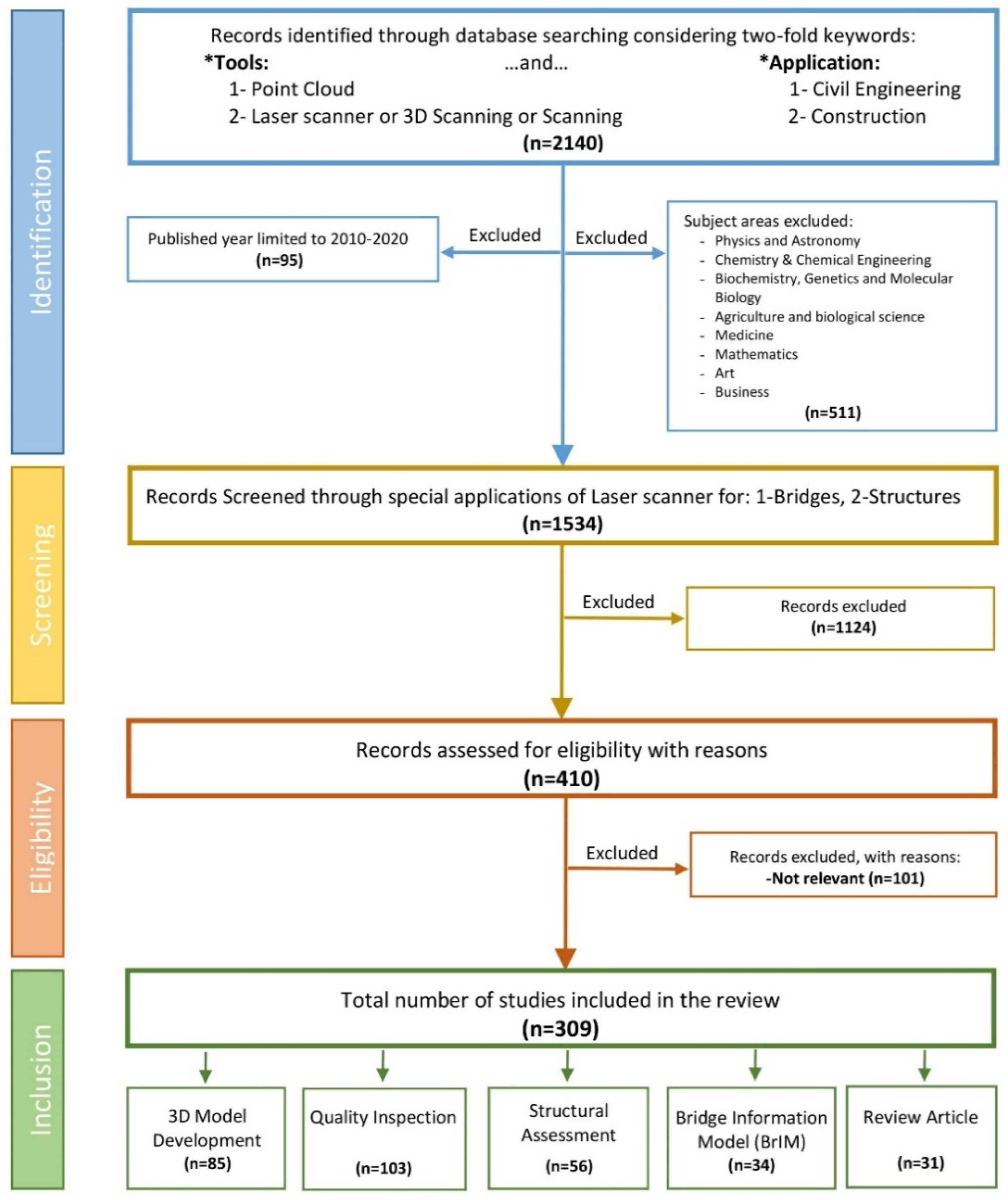
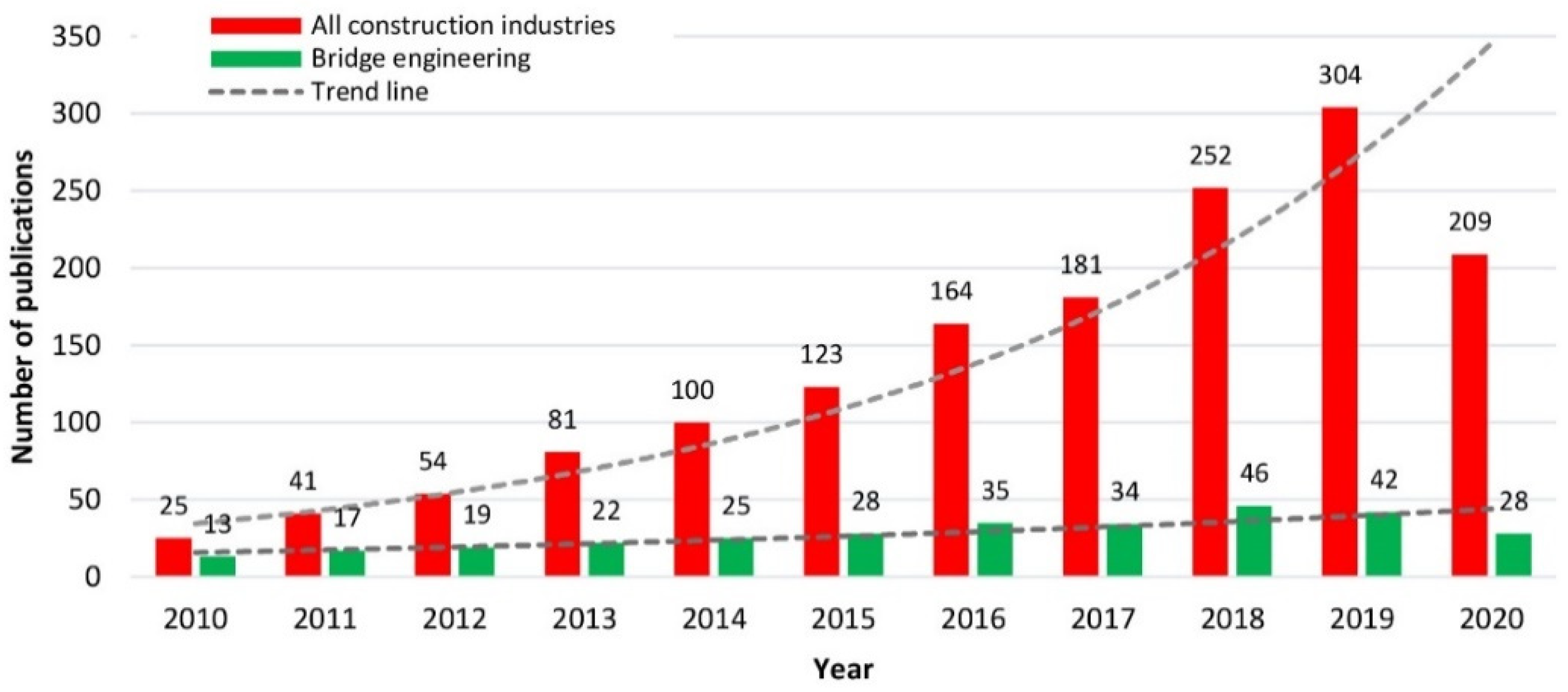
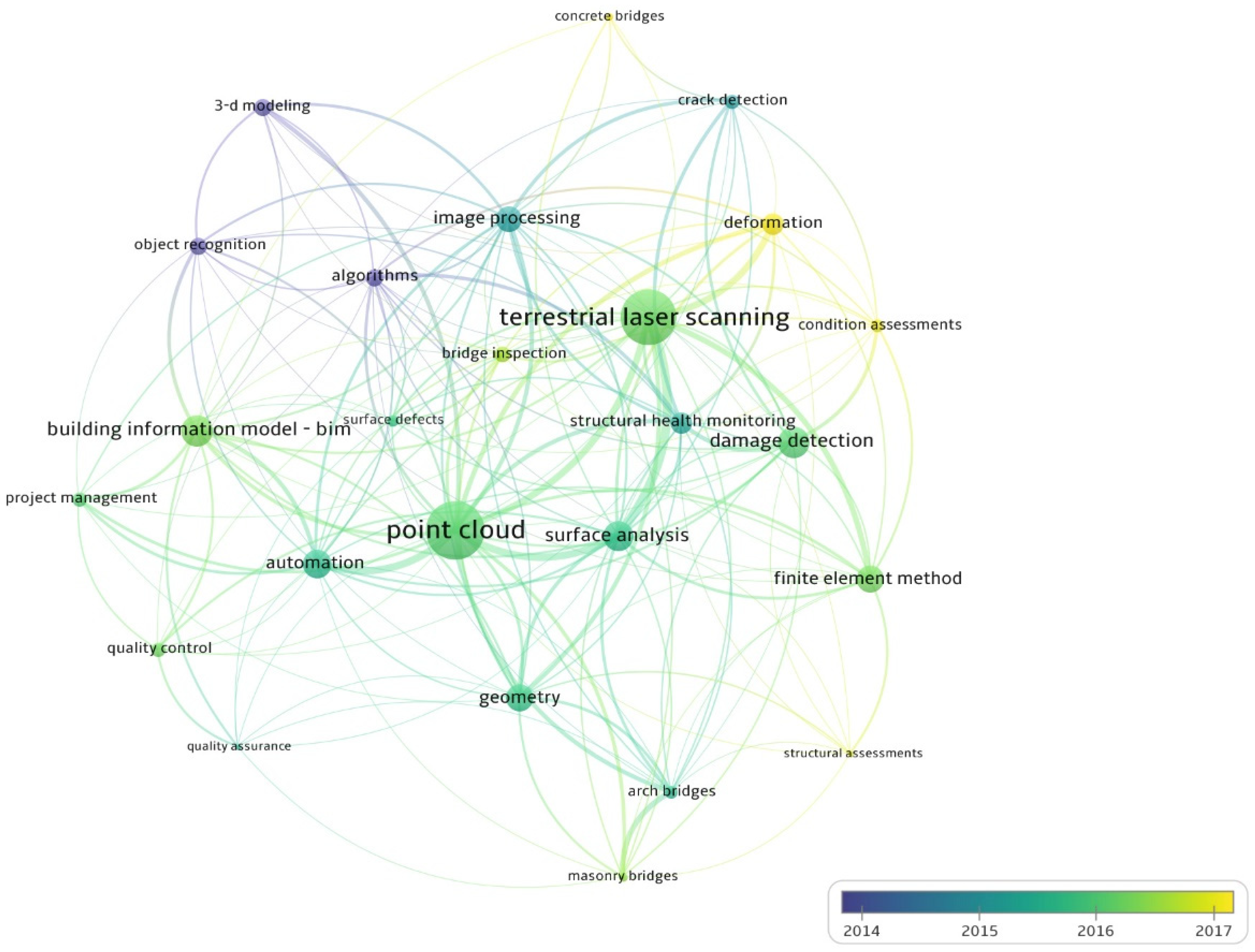
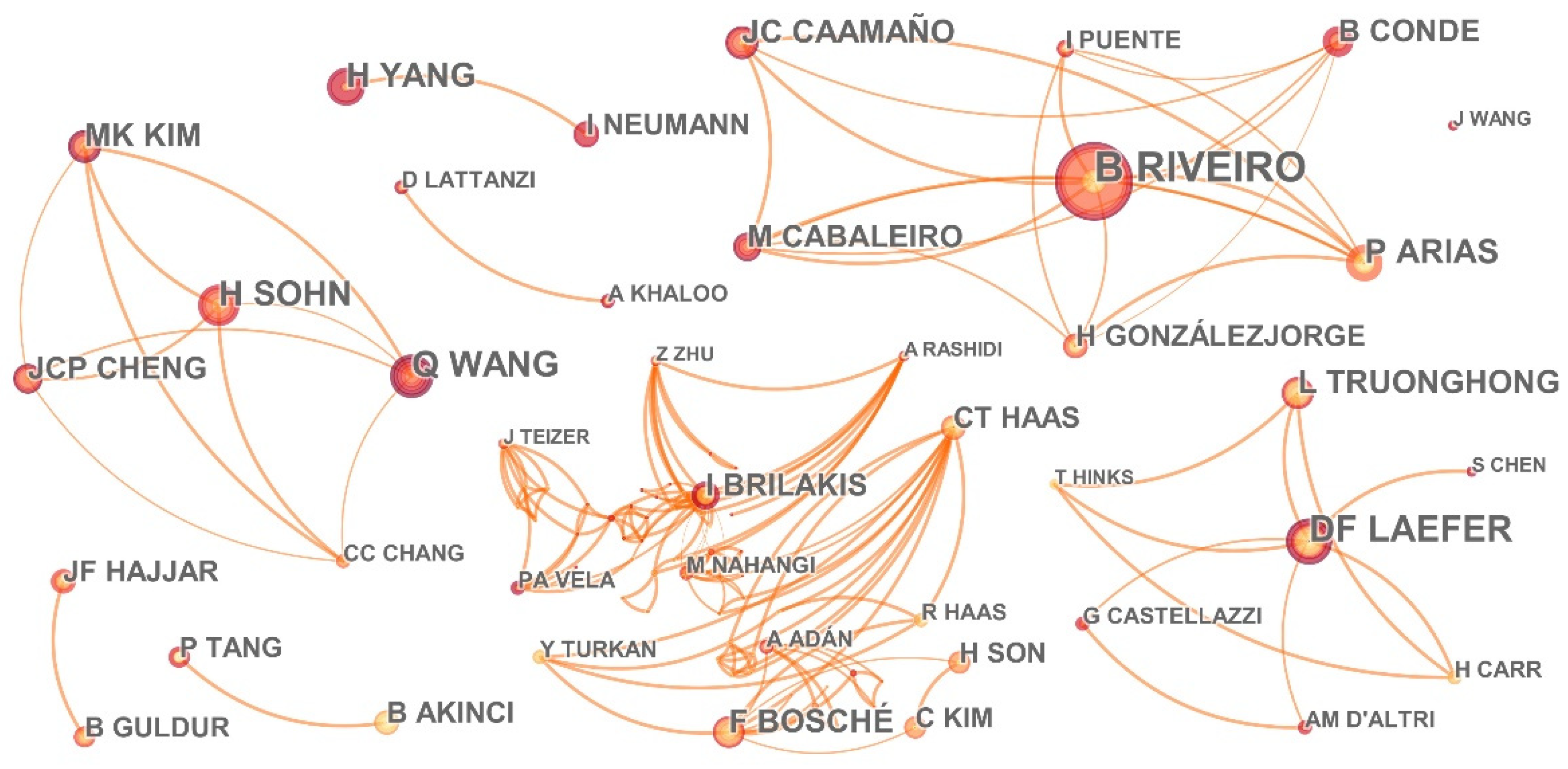
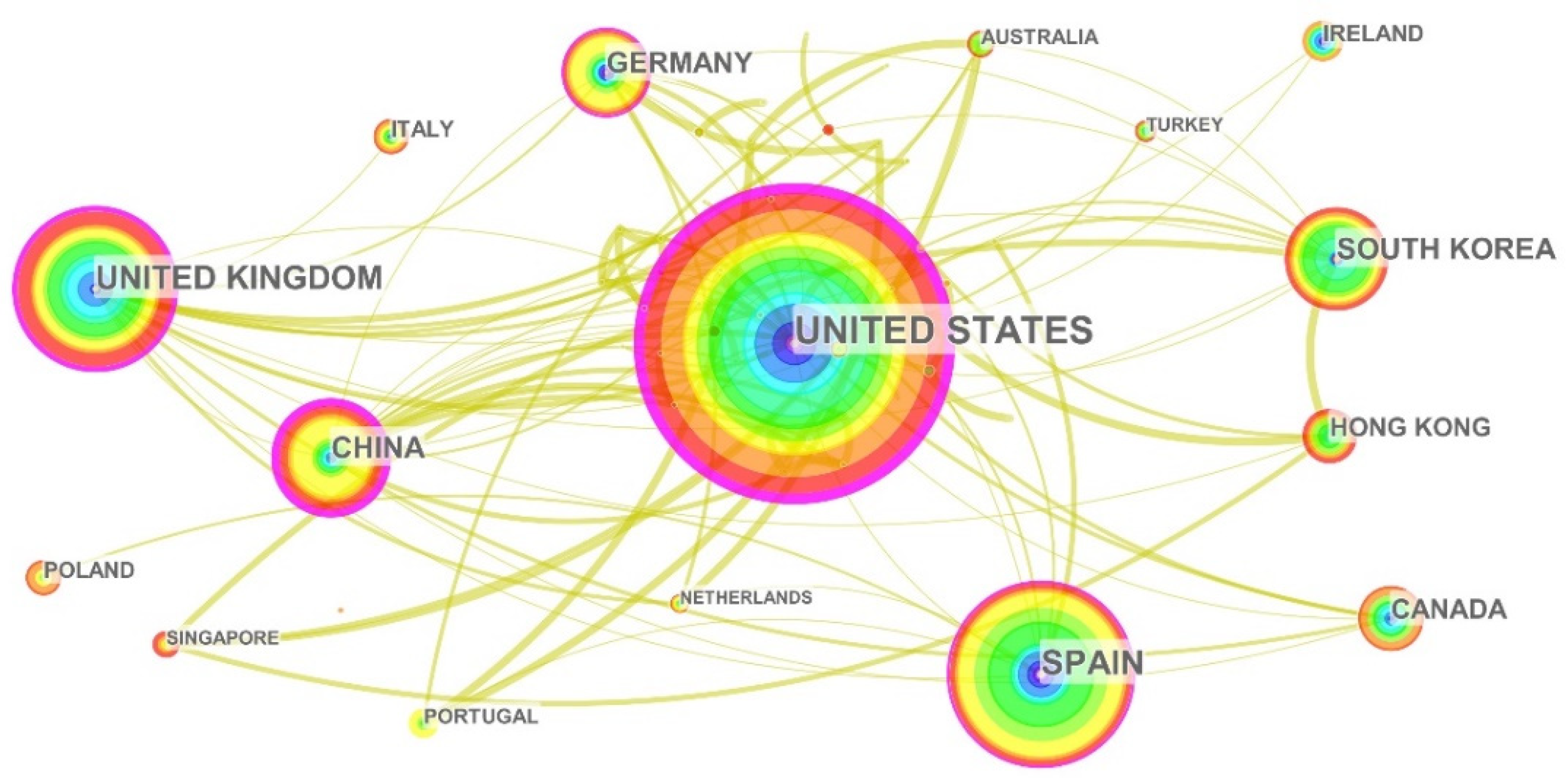
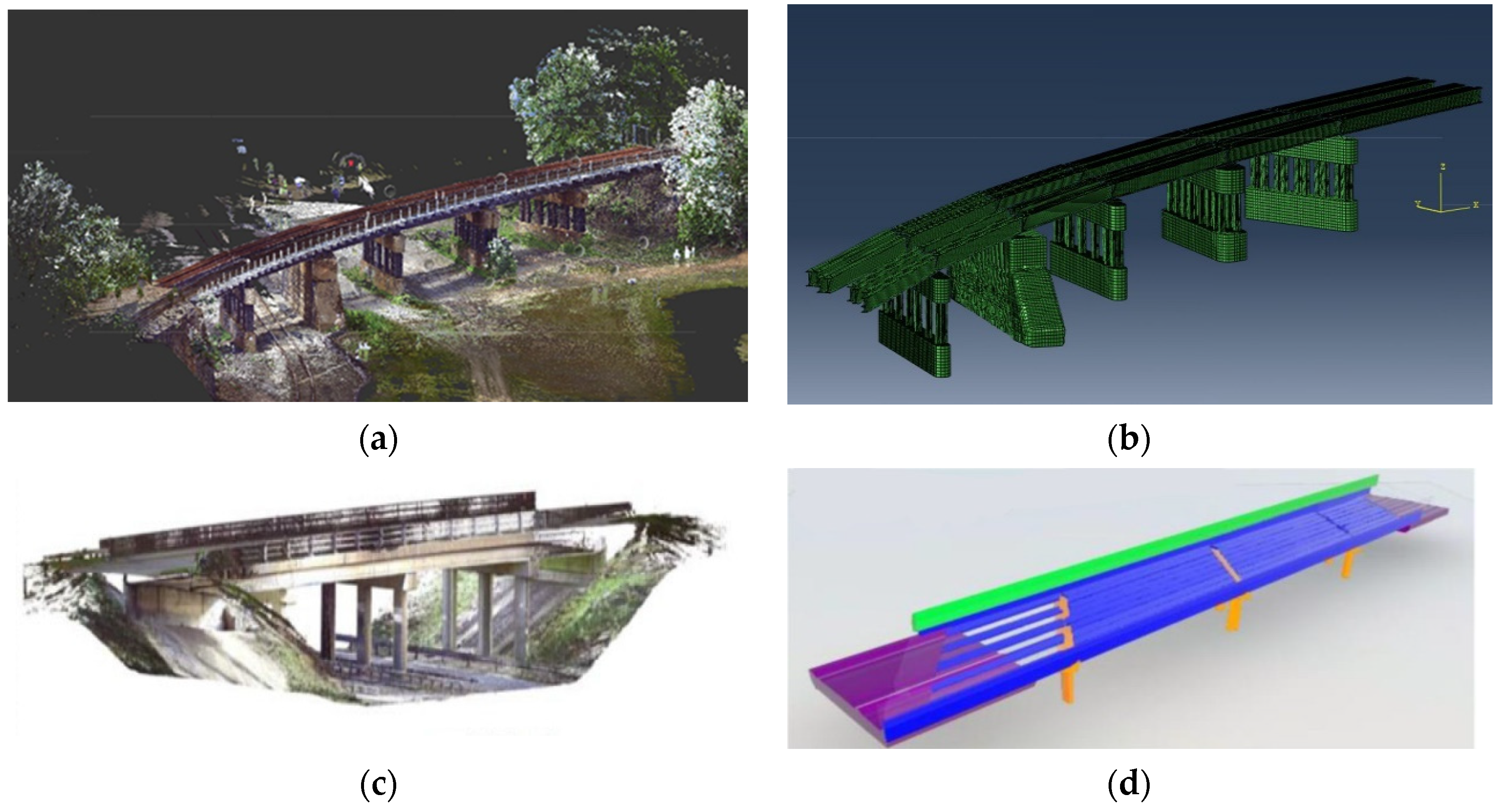
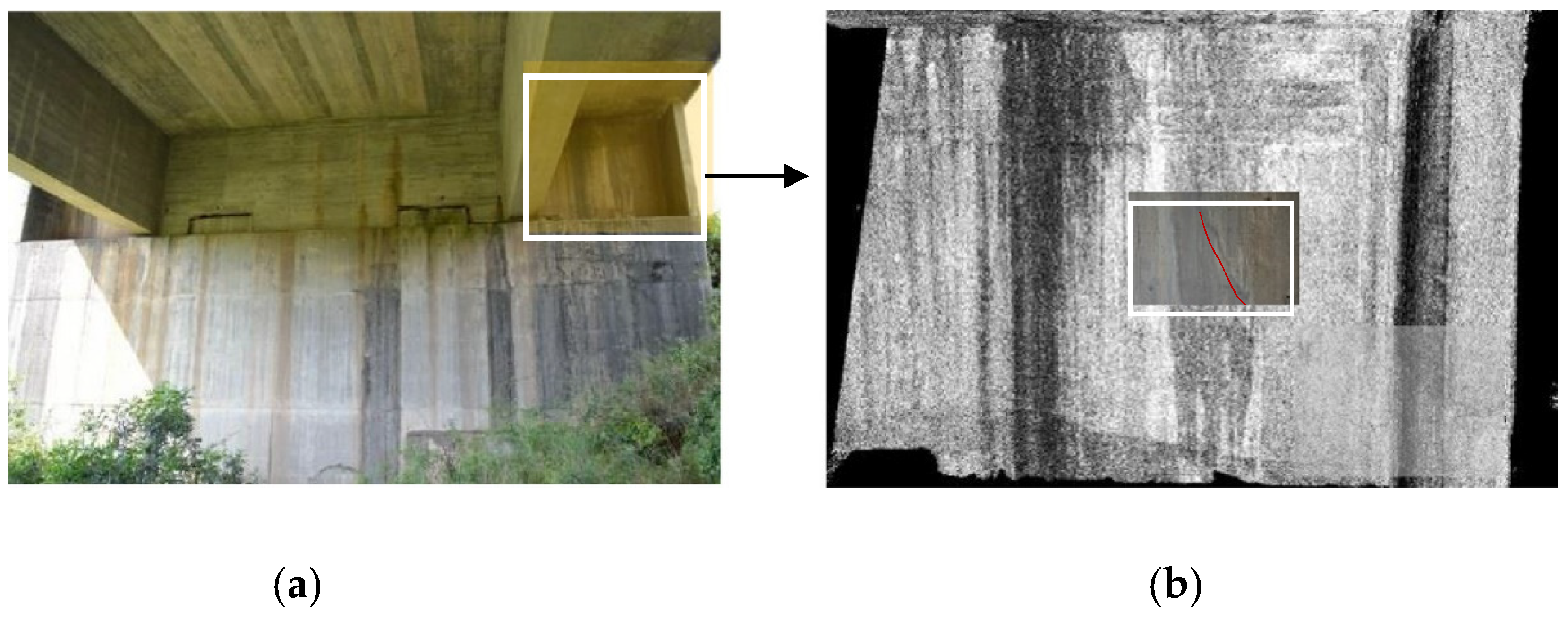
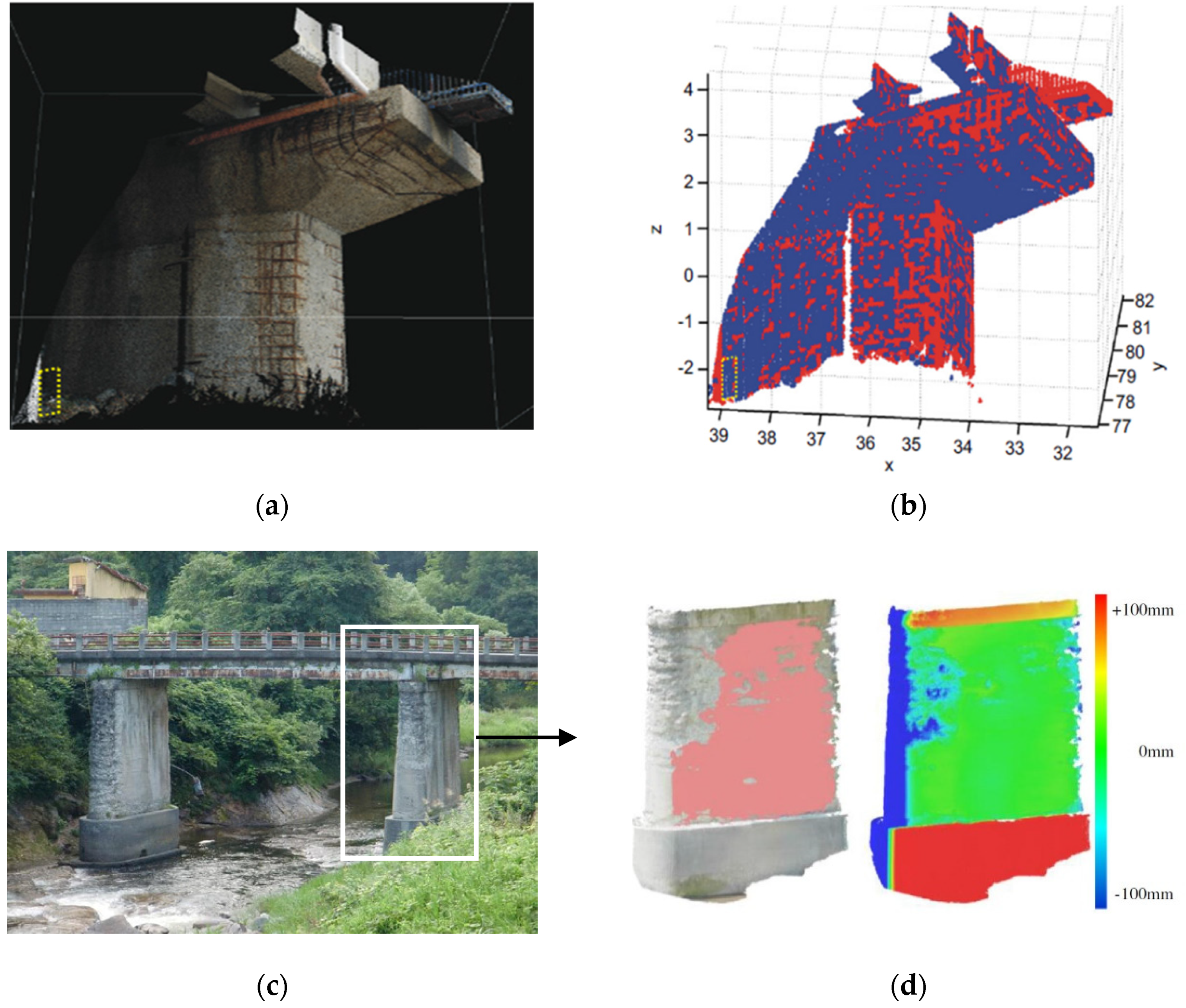
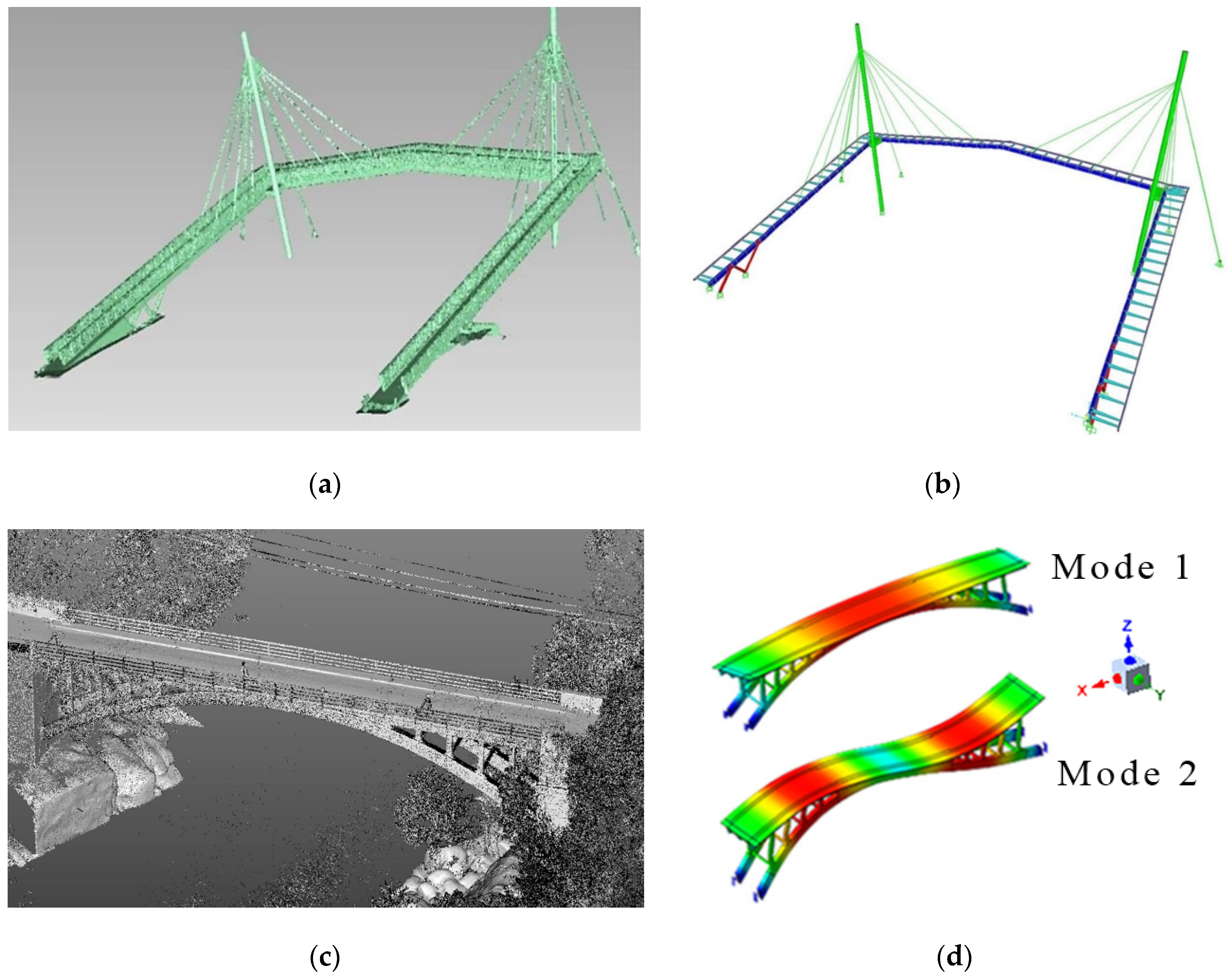
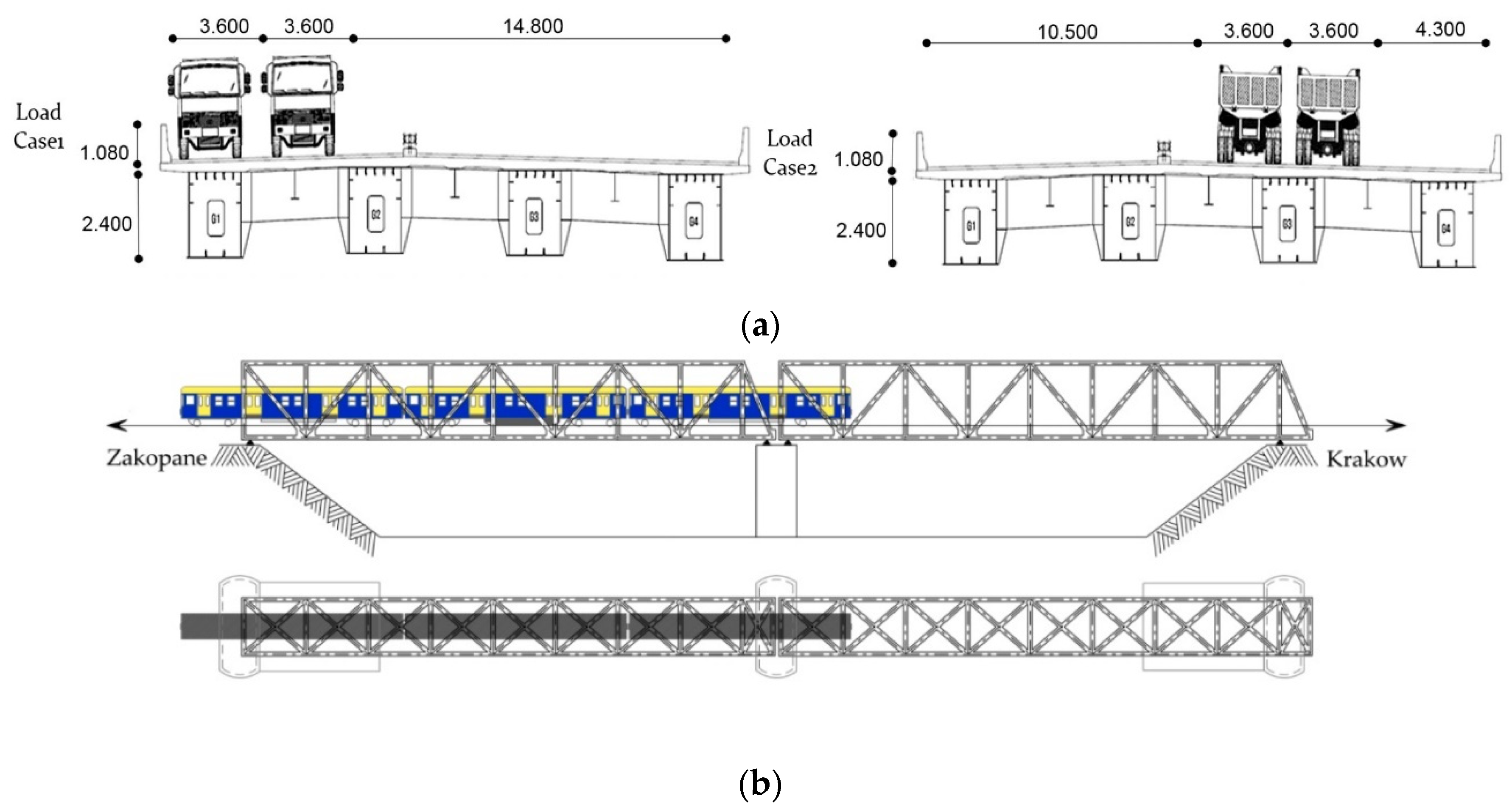
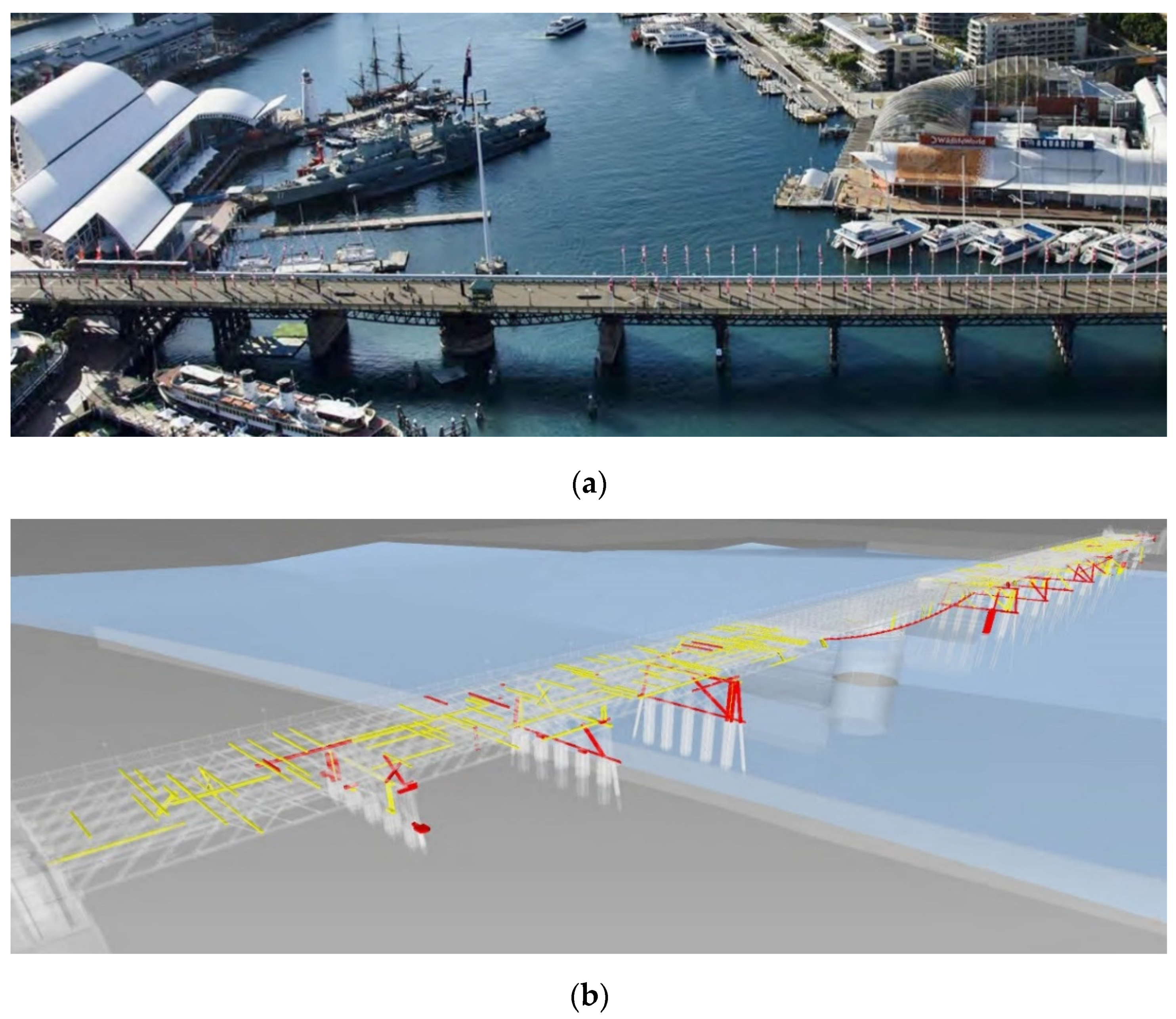
| Journal Title | Number of Relevant Articles | % of Total Included Publications |
| Automation in Construction | 56 | 18% |
| Remote Sensing | 15 | 5% |
| Advanced Engineering Informatics | 13 | 4% |
| Journal of Computing in Civil Engineering | 11 | 4% |
| Structural Control and Health Monitoring | 11 | 4% |
| Construction and Building Materials | 10 | 3% |
| Conference Title | Number of Relevant Articles | % of Total Included Publications |
| ISPRS, International Archives of the Photogrammetry, Remote Sensing and Spatial Information Sciences | 10 | 3% |
| ISARC, International Symposium on Automation and Robotics in Construction | 3 | 1% |
| Congress on Computing in Civil Engineering | 3 | 1% |
| Keyword | Occurrence | Average Year Published | Links | Total link Strength | % of Total Occurrence | |
|---|---|---|---|---|---|---|
| 3D Model Development | ||||||
| Point cloud | 58 | 2016 | 22 | 105 | 12% | 48% |
| Terrestrial laser scanning | 55 | 2016 | 21 | 78 | 11% | |
| Image processing | 24 | 2015 | 21 | 56 | 5% | |
| Structural health monitoring | 20 | 2015 | 17 | 52 | 4% | |
| Automation | 26 | 2015 | 17 | 49 | 5% | |
| Finite element method | 25 | 2016 | 15 | 36 | 5% | |
| Algorithms | 16 | 2013 | 18 | 36 | 3% | |
| 3D modeling | 15 | 2013 | 8 | 20 | 3% | |
| Quality Inspection | ||||||
| Damage detection | 30 | 2016 | 17 | 42 | 6% | 27% |
| Geometry | 25 | 2015 | 16 | 43 | 5% | |
| Object recognition | 15 | 2013 | 12 | 25 | 3% | |
| Bridge inspection | 14 | 2016 | 11 | 24 | 3% | |
| Crack detection | 13 | 2015 | 11 | 26 | 3% | |
| Arch bridge | 11 | 2015 | 14 | 36 | 2% | |
| Surface defects | 10 | 2015 | 13 | 21 | 2% | |
| Concrete bridges | 6 | 2018 | 8 | 8 | 1% | |
| Masonry bridges | 8 | 2016 | 11 | 28 | 2% | |
| Structural Assessment | ||||||
| Surface analysis | 28 | 2015 | 19 | 70 | 6% | 13% |
| Deformation | 19 | 2017 | 11 | 36 | 4% | |
| Condition assessments | 11 | 2016 | 11 | 21 | 2% | |
| Structural assessment | 5 | 2016 | 9 | 12 | 1% | |
| Construction Management | ||||||
| Building information model- BIM | 30 | 2016 | 15 | 45 | 6% | 12% |
| Project management | 13 | 2016 | 10 | 21 | 3% | |
| Quality control | 12 | 2014 | 11 | 22 | 2% | |
| Quality assurance | 5 | 2015 | 9 | 13 | 1% | |
| Network | Nodes | Links | Density | Modularity, Q | Mean Silhouette Score |
|---|---|---|---|---|---|
| Co-authorship | 521 | 1012 | 0.0075 | 0.9567 | 0.9136 |
| Author | Institution | Country | Count | Percentage |
|---|---|---|---|---|
| Riveiro, B. | University of Vigo | Spain | 22 | 7% |
| Laefer, D.F. | New York University | USA | 13 | 4% |
| Wang, Q. | National University of Singapore | Singapore | 12 | 4% |
| Sohn, H. | Korea Advanced Institute of Science and Technology | South Korea | 11 | 4% |
| Arias, P. | University of Vigo | Spain | 10 | 3% |
| Yang, H. | Jiangsu University of Science and Technology | China | 10 | 3% |
| Truong-Hong, L. | Delft University of Technology | Netherlands | 9 | 3% |
| Bosché, F | University of Edinburgh | United Kingdom | 9 | 3% |
| Materials | Components | Detected Crack | TLS | References | |||
|---|---|---|---|---|---|---|---|
| Width (mm) | Length (mm) | Scan Range (m) | Resolution | ||||
| Concrete | Wall and Slab | [47,91,92,93,94,95,96,97,98,99] | |||||
| 2.7~20 | 620 | 2.5 | 6 mm @ 50 m | [47] | |||
| Façade | |||||||
| >1.13 | >88 | 20~35 | 5 mm @ 100 m | [100] | |||
| Beam | [101] | ||||||
| Pavement | [102,103] | ||||||
| Cylindrical specimen | [104,105] | ||||||
| Brick | Wall | ||||||
| 1~7 | _ | 5~12.5 | 0.4 mm @ 11 m | [46] | |||
| Façade | |||||||
| >0.85 | >90 | 20~35 | 5 mm @ 100 m | [100] | |||
| Timber | Beam | ||||||
| 3~13 | 30~590 | <7.5 | <1 mm @ 10 m | [48] | |||
| Damage Type | Components | Detected Damage | TLS | References | ||
|---|---|---|---|---|---|---|
| Area | Depth | Scan Range (m) | Resolution | |||
| Mass loss | [91,101,106,108] | |||||
| Concrete pier | >50% of surface | _ | 80 | 5 mm @ 50 m | [106] | |
| Concrete girder | 8% of surface | _ | 20 | 5 mm @ 50 m | [106] | |
| Steel girder | >50% of surface | _ | <20 | 2 mm @ 10 m | [91,101] | |
| Timber pier | >30% of surface | _ | <20 | 2 mm @ 10 m | [91] | |
| Scaling | [109,113] | |||||
| Concrete pier | _ | <100 mm | 10~30 | 5 mm @ 600 m | [109] | |
| Concrete surface | >30 mm across | >1 mm | 3~20 | 0.014°~0.036° | [113] | |
| Spalling | [91,101,111,112] | |||||
| Concrete deck | >10% of surface | _ | <20 | 2 mm @ 10 m | [91,101] | |
| Concrete panel | <180 mm × 180 mm | <30 mm | 4~12 | 2 mm @ 20 m | [112] | |
| Damage Type | Components | Detection Method | TLS | References | |
|---|---|---|---|---|---|
| Scan Range (m) | Resolution | ||||
| Corrosion | [91,101,125] | ||||
| Steel truss element | Point cloud classification | <10 | 5 mm @ 100 m | [125] | |
| Steel girder | Surface normal based | <20 | 2 mm @ 10 m | [91,101] | |
| Water bleeding | [121,123] | ||||
| Concrete pier | K-means and fuzzy C-means | 9~17 | 6 mm @ 50 m | [121] | |
| Concrete pier | Support vector machine | 63 | 1.6 mm @ 10 m | [123] | |
| Efflorescence | [120,123,124] | ||||
| Concrete wall | Real-time | <200 | 1 mm @ 100 m | [120] | |
| Bridge Type | Span (m) | Measured Deflection, Maximum (mm) | TLS Resolution | Load Type | References |
|---|---|---|---|---|---|
| Steel girder | 100 | 4.82 | 35 mm @ 300 m | Static load by trucks | [136] |
| Steel truss | 52.7 | 18.2 | 1.5 mm @ 10 m | Static load by train | [137] |
| Concrete viaduct | 156 | 14 | 2 mm @ 25 m | Static load by tanks | [159] |
| Cable-stayed | 307 | 350 | 5 mm @ 100 m | Static load | [160] |
| Concrete cantilever | 17.5 | 35 | 6 mm @ 50 m | Static load by blocks | [163] |
| BRIDGE TYPE | Span (m) | TLS | BrIM Application | Location | References | |
|---|---|---|---|---|---|---|
| Scans | Resolution | |||||
| Concrete slab | 5 | 18 | 2 mm @ 10 m | Management | Cambridge, UK | [79,80] |
| Concrete viaduct | 24 | _ | 3 mm @ 10 m | Condition assessment | Koszalin, Poland | [128] |
| Stone arch | 29 | 12 | 2 mm @ 10 m | Condition assessment | Alcántara, Spain | [130] |
| Stone arch | 11.5 | 10 | 2 mm @ 10 m | 3D model and assessment | Mondariz, Spain | [147] |
| Cable-stayed | 27 | _ | 6 mm @ 50 m | 3D model and assessment | Vigo, Spain | [156] |
| Concrete arch | 35 | 18 | 2 mm @ 25 m | 3D model and assessment | Amares, portugal | [157] |
| Masonry arch | 15.5 | 6 | 6 mm @ 50 m | Condition assessment | Killorglin, Ireland | [161] |
| Iron truss | 52 | 2 | 5 mm @ 50 m | Condition assessment | Dublin, Irland | [164] |
| Concrete girder | 25 | 12 | 3 mm @ 10 m | Condition assessment | _ | [186] |
| Concrete girder | 5.2 | 14 | 2 mm @ 10 m | Management | Acworth, USA | [190,193] |
| Cast iron cable | 21.2 | 10 | 2 mm @ 10 m | Condition assessment | Ozimek, Poland | [194] |
Publisher’s Note: MDPI stays neutral with regard to jurisdictional claims in published maps and institutional affiliations. |
© 2020 by the authors. Licensee MDPI, Basel, Switzerland. This article is an open access article distributed under the terms and conditions of the Creative Commons Attribution (CC BY) license (http://creativecommons.org/licenses/by/4.0/).
Share and Cite
Rashidi, M.; Mohammadi, M.; Sadeghlou Kivi, S.; Abdolvand, M.M.; Truong-Hong, L.; Samali, B. A Decade of Modern Bridge Monitoring Using Terrestrial Laser Scanning: Review and Future Directions. Remote Sens. 2020, 12, 3796. https://doi.org/10.3390/rs12223796
Rashidi M, Mohammadi M, Sadeghlou Kivi S, Abdolvand MM, Truong-Hong L, Samali B. A Decade of Modern Bridge Monitoring Using Terrestrial Laser Scanning: Review and Future Directions. Remote Sensing. 2020; 12(22):3796. https://doi.org/10.3390/rs12223796
Chicago/Turabian StyleRashidi, Maria, Masoud Mohammadi, Saba Sadeghlou Kivi, Mohammad Mehdi Abdolvand, Linh Truong-Hong, and Bijan Samali. 2020. "A Decade of Modern Bridge Monitoring Using Terrestrial Laser Scanning: Review and Future Directions" Remote Sensing 12, no. 22: 3796. https://doi.org/10.3390/rs12223796
APA StyleRashidi, M., Mohammadi, M., Sadeghlou Kivi, S., Abdolvand, M. M., Truong-Hong, L., & Samali, B. (2020). A Decade of Modern Bridge Monitoring Using Terrestrial Laser Scanning: Review and Future Directions. Remote Sensing, 12(22), 3796. https://doi.org/10.3390/rs12223796










